#second serve 1986
Photo


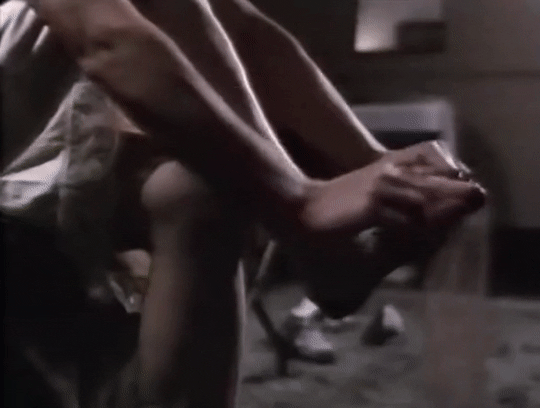


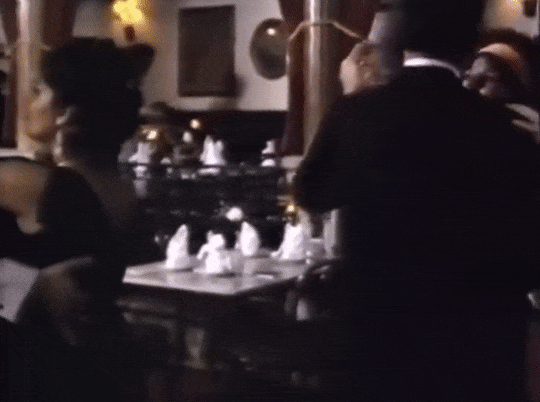




SECOND SERVE (1986)
dir. Anthony Page
Based on the life of tennis pro Renée Richards. In 1976, Renée is an ophthalmologist with a successful career, a beautiful fiancée and a secret life as a closeted trans woman. When her psychiatrists and mother fail to "cure" her, Renée leaves her life behind and moves to California, where she feels free enough to become herself and take up professional tennis. But when a reporter outs her, she must fight for her right to compete.
(link in title)
#lgbt cinema#trans cinema#second serve#renee richards#second serve 1986#us cinema#lgbt#trans#transgender#usa#lgbt film#trans film#trans movie#lgbt movie#lgbt media#trans media#queer cinema#american cinema#vanessa redgrave#martin balsam#william russ#1986#80s#1980s#80s movies#80s films#1980s movies#1980s cinema#1980s film
16 notes
·
View notes
Text
i found jay’s black jacket (an ID guide)

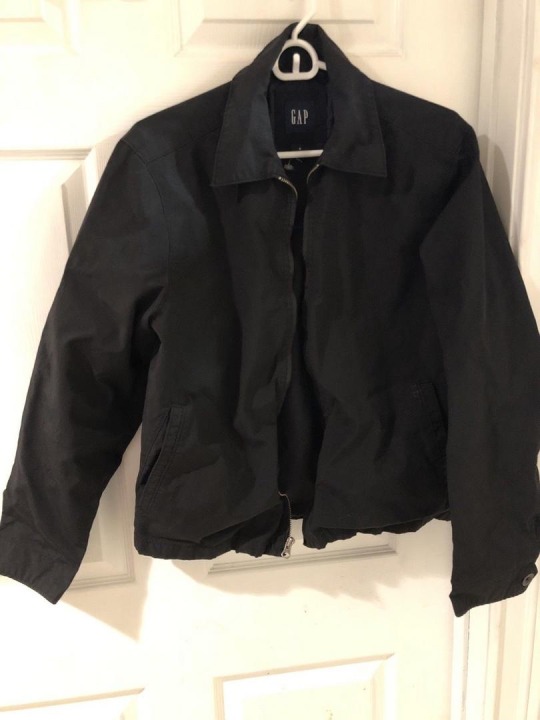
This black jacket is worn by Jay about 9 times throughout Marble Hornets, including his final appearance. And after some weeks of on-and-off research, I think I know the exact make and model.
This post will detail exactly how I found it, and serve as a guide for anyone that wants to find the jacket, whether that's for cosplay purposes, or if you're just keen on collecting items related to MH.
Main post under the cut
Intro

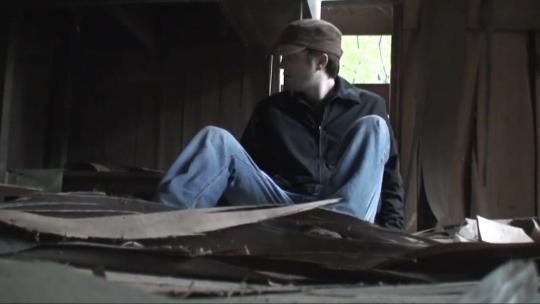

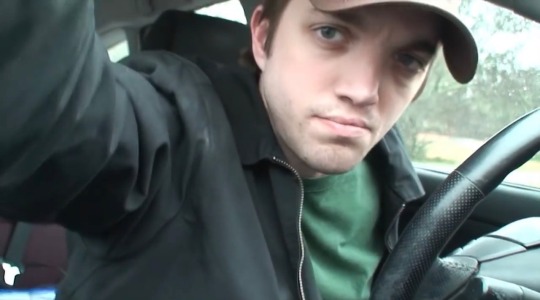
The first step to identifying the jacket was to gather as many references as possible.
I went back to the web series and took screenshots from any entries the jacket makes an appearance. (shoutout to mg549′s very comprehensive MH wardrobe guide, without it this would’ve been much more of a pain)
Jay's jacket is, for the most part, very plain. It's a solid color, full-zip jacket, without any particularly eye-catching logos or other details. I had to look for moments where even the slightest distinction appeared clear on camera, at least as distinct as it can be. Even if it was just close-ups to get the shape of a zipper, or how many buttons are on a sleeve, it was the best I got.
While I did manage to find a decent amount of these, there was just one crucial detail that would've made finding it near-impossible; the brand is never shown. Thankfully, I had another resource.
In 2018 Troy Sold a Lot of Stuff

In early 2018, Troy officially announced that MH would be continued in a comic series. To fund the first issue, he held a number of auctions for production items used during the web series on Ebay.
These included items such as Jay’s camera, Brian’s hoodie, A Masky mask, and Jay’s black jacket.

Lo and behold, the jacket listing includes a picture with the brand in clear view. It's from Gap.
Ebay does not archive sold listings older than 90 days. However, Worthpoint, a website for valuing and pricing collectibles, does. Using Worthpoint I was able to find all of these items, (and a lot more, which can be found in this doc I submitted to Archive Hornets)
Identification
With the picture from the listing and the series screencaps, I had a complete ID list.


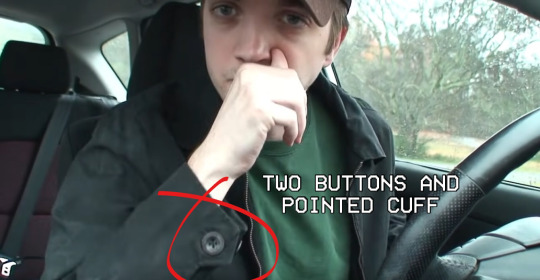
(Top image is from the Ebay listing, with the contrast adjusted a little for easier viewing. The bottom two images are from Entry #79)
The Gap logo (This specific logo dates the jacket being made anywhere between 1986 and 2009, when it first appears).
Front Zipper (Note the shape)
The two front pockets
The two buttons and pointed cuffs on each sleeve (Second one is a little hard to see but it's jusstt peeping out at the side)
The blue piping in the inner lining
The zipper in the right side inner lining
The gray mesh inner lining
With these in mind, I could now go to the next and longest step-
Finding the Jacket
I combed three resell sites; Ebay, Depop, and Poshmark. My main goal wasn't to actually purchase the jacket, (although, I would like to at some point) but to find a jacket listing that had every identifier, and have a more definite baseline for finding others. I needed to be sure what I had was enough to properly ID the jacket. The references I had stitched together were decent enough, but I wanted to see if there was something better out there.
After tons of page scrolling and tab-switching and comparing and contrasting, I finally got lucky.







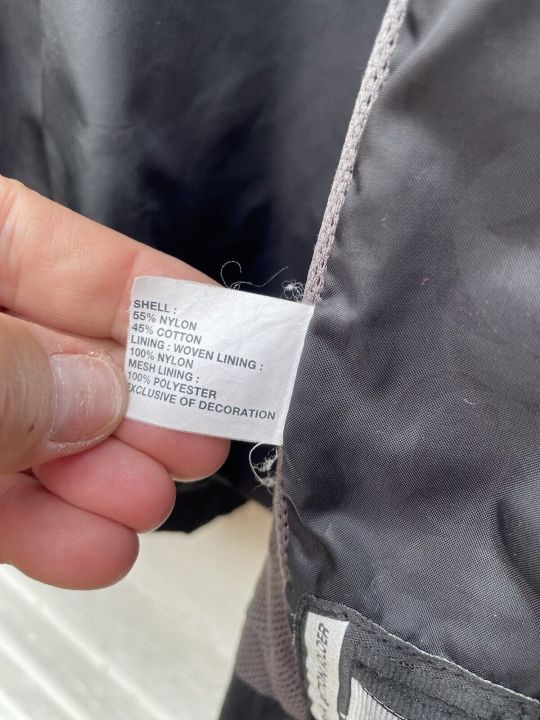
(first two images are from crashthecloset's listing on poshmark, last six are from shannfo-76 on ebay)
I haven't bought one myself as of posting, but I feel pretty confident this is it. The jackets were already sold, but every marker seemed to be accounted for. It also revealed new ones, like the reflective pattern and pockets on the inner lining, (zipper on the right side pocket, button on the left pocket) and the materials tag.
With that, here's some final notes that may be helpful if you try looking for the jacket yourself:
Online sellers often describe it as a light jacket, a windbreaker, a 2-in-1, or 3-in-1.
"Gap Mens Black Jacket" is the search phrase I used the most since it yielded a (very) broad result pool.
Most of the jackets I found came from Poshmark or Ebay.
The exact size of Jay’s jacket is unclear. My best guesses are either a US Men’s S or M, since Jay was pretty skinny and of average height. I’ve only been able to find maybe 2 jackets that are a size M, one of which is the first pic in the photoset above.
Gap has sold other black jackets that look remarkably similar to Jay’s, and they do pop up on resell sites. One of these was so similar, the only discernible difference was the style of the logo. I highly recommend making sure it matches the exact one Jay had before purchasing. (It's also more than fine to ask/msg me if you have any doubts!) As long as you know what to look for, you shouldn’t have a problem finding at least one.
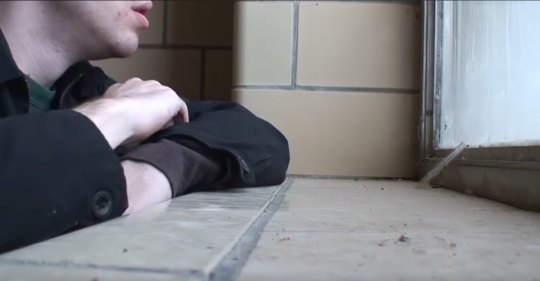
One detail that confounded me was this sleeve poking out of Jay's jacket. At first I thought he was wearing a long sleeve underneath, making this shot a continuity error since he appeared to Only be wearing the green short sleeve under the jacket.
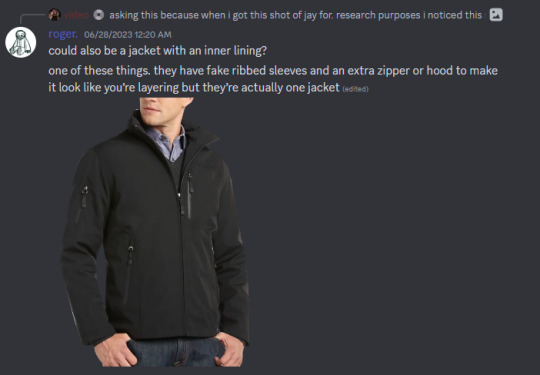

@hivemite pointed out that this might be a two-in-one jacket, which has multiple layers for different types of weather. While I have not been able to see the sleeve outside of two shots in entry #79 and #80, one listing I found did describe it as a 3-in-1.

that's about it! hope this helps :)
#marble hornets#jay merrick#ref#over and out#long post#happy entry 80 day. heres some extra tidbits just for the tags#at least two listings called this y2k which is really funny.#it is also strangely difficult to find these in sizes smaller than large#another thing kinda related. worthpoint is a shitty site unfortunately#as you can see with the jacket description. in which it apparently ‘‘works and comes with a charging cable’’#<- i mean that Couldve been an error on the original ebay listing#however that is. impossible to verify now unless someone somewhere had a screenshot#but each mh item from this particular auction there had consistently bad errors that inclines me to say that wasnt the case#ok this went too long for a few extra tidbits but can you tell i lost my mind
428 notes
·
View notes
Text
Timothy Laurence

Physique: Average Build
Height: 6’ 3" (1.91 m)
Vice Admiral Sir Timothy James Hamilton Laurence, KCVO, CB, CSM, ADC (born 1 March 1955 -) is a retired Royal Navy officer and the second husband of Anne, Princess Royal, the only sister of King Charles III. Laurence was equerry to Queen Elizabeth II from 1986 to 1989.

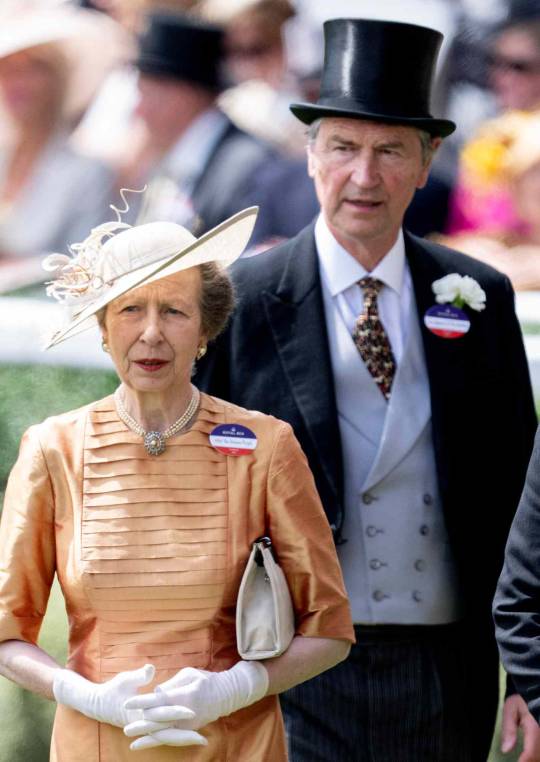



Tall, handsome with a thin frame, Sir Timothy could get more than just a courtesy tap. He is also not considered a working royal, but over the years has supported his wife throughout her royal duties. He has accompanied her on royal events and royal tours.
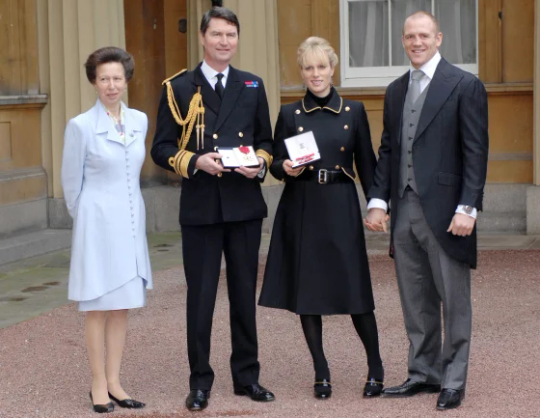




Laurence met Princess Anne when he served as an equerry to Queen Elizabeth II in 1986, at a time when it was much rumored that her first marriage to Captain Mark Phillips was breaking down. Not hard to see why Anne fell for him. Apparently, the affair with her future husband eventually led to her official separation in 1989 and they later married in 1992. Personally, I think that was a lateral move. The couple never had any children of their own once they got married, but he's a supportive step-father to Anne's two children.
Anyway, I like to have some alone time with the Vice Admiral. Though the princess can join in.

79 notes
·
View notes
Text



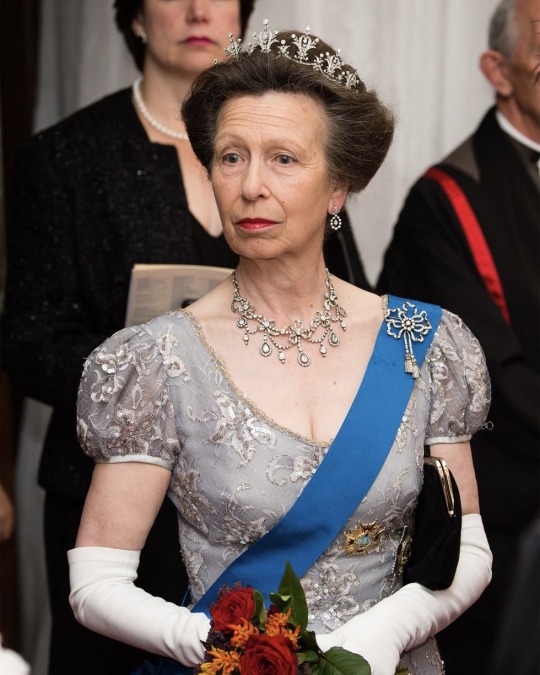
Happy 73rd birthday to Princess Anne!
Born on 15 August 1950, Anne Elizabeth Alice Louis is the second child and only daughter of Queen Elizabeth II and Prince Philip, Duke of Edinburgh, and the only sister of King Charles III. She is currently 17th in the line of succession to the British throne.
She is patron or president of over 300 organisations, including WISE, Riders for Health, and Carers Trust.
Anne married Captain Mark Phillips in 1973; they separated in 1989 and divorced in 1992. They have two children, Peter Phillips and Zara Tindall, and five grandchildren. Within months of her divorce in 1992, Anne married Commander (later Vice Admiral) Sir Timothy Laurence, whom she had met while he served as her mother's equerry between 1986 and 1989.
92 notes
·
View notes
Note
80’s Hackearney Drabble idea, comin’ in hot!
Snack Time at Hackett’s Quarry
- popsicles or soft serve ice cream maybe?
- maybe something more wholesome, like juicy watermelon slices that inevitably dribble down someone’s chin?
- do the campers and counsellors ever have to do their own baking, and if so, poor young Travis having to put up with various “bun in oven” and “buttered muffin” jokes from the others
Hell yes, sweet treats!
It's the second Saturday in June at Hackett's Summer Camp and apparently it's known as Sweet Saturday. Laura's informed that this is the day all the campers work on making sweet treats to trade with one another.
The treats don't have to be particularly difficult - just fun to put together. Laura's never considered herself much of a cook - hell, before this she wasn't even a very good waitress, aka the person who delivers the food - but luckily she gets the youngest campers.
The idea of using fruit juice to make easy popsicles via ice trays pleases them immensely and even Laura finds herself having fun as she helps the little kids carefully pour their chosen juice into the tray's little cups - sticking toothpicks in their centers.
As the evening rolls in the treats start being swapped and Laura can't help but feel a glow of pride as she sees the tiny popsicles floating around among the cookies, muffins, and slices of cake.
The cake really intrigues her, as it doesn't look like an ordinary cake, which she discovers is the truth when she's presented with a slice by Chris, "Here! Take some icebox cake!"
It's always beyond bizarre when Laura is faced with a young Chris. After all, he was - in many ways - the kick off for her woes in 2021. But now, in 1986, he's young and innocent and eager to please as he forces the small paper plate on her, "C'mon - join T and me. We've got a great spot!"
Laura gamely follows along, seeing Travis resting against a tall, thick tree near the dock. Travis is picking at his food, as if unsatisfied with it when he catches sight of her with his sibling.
His back goes ramrod straight even as he pushes his glasses by the bridge up his nose. He gives her that awkward (annoying) endearing (goofy) smile as he greets her with a quiet, "Uh, hey."
"Hey." Laura returns just as noncommittally even as Chris takes a seat next to Travis and beams, "Brought Laura over to snack with us. Hope that's okay."
Travis shoots Chris a look that Laura recognizes as a secret, brother-based look. While she doesn't have siblings of her own, Laura's been friends with, and seen enough, brothers and sisters shoot one another that look - the inside kind that only they understand, to get that that's what she's seeing.
However, if the look shot his way bothers him, Chris doesn't show it as he digs into his large collection of treats, chocolate melting all over his fingers as he breaks apart a cookie
Laura sits across from the brothers and watches with quiet amusement until Chris asks, "You have a favorite yet, Laura? These cookies from Nancy's group is my favorite so far."
"I haven't tried them yet."
"Oh! You gotta! Here!" Chris offers her half of the cookie he just tore into and she takes it, feeling a slight pang of guilt as she does so.
Jesus, she led the charge to kill this guy in the future and here he's giving her a cookie. Still, she pushes the thought aside and tries to act normal, biting into the treat and trying to enjoy it.
Chris nudges Travis and chuckles, "Don't worry! She has some of your cake too!"
Travis looks at her and Laura feels like she's chewing in the most unattractive way possible so she swallows a big hunk of what's left in her mouth and then coughs, clearing her throat as she holds up the paper plate Chris gave her.
Travis's lips squirm like he's fighting off a smile. Chris has no resistance, smiling widely, "It's our Grandma's recipe! Ma taught us!"
"She did, huh." Laura tries to keep the bitterness out of her voice. Mrs. Hackett is the last thing she wants to hear about when she's trying to enjoy something sweet.
"Yup! It's got vanilla pudding and graham crackers and whipped cream and-!"
"She doesn't need the ingredient list, bud." Travis grumbles and Chris rolls his eyes, "Whatever. You're just upset they didn't have watermelons this year."
Laura's eyebrows rise, "You like watermelons?"
Every time she learns something new about Travis it's always so... surprising. She can't say why, other than the fact that - as her jailor - he'd seemed so remote and distant. So cold. As if he didn't like anything past being a bastard.
But in this time - when he's young and open - she's slowly uncovered more and more about him and each thing seems more startling than the last.
"You bet he does! Sometimes we have spitting contests with the seeds!"
Travis looks appropriately mortified at this and Laura can't help the genuine laugh that escapes her. Clearly hoping to continue his entertaining streak, Chris rattles on, "You should see him go! His face gets all wet and sloppy and the juice dribbles down his chin from chowing down and he makes all these noises and-!"
"Shut it, doofus!" Travis hisses and he pushes hard at his brother's shoulder. Normally Laura might object, but Chris's innocent descriptions and the way Travis's face started to turn pink hints to something that makes her feel... peculiar.
Like she'd like to see Travis's face wet with the clear juice of the watermelon. His lips shiny...
Laura fans at herself and excuses it as an unexpected spike in the temperature, nevermind that the sun is setting. She takes a bite of the icebox cake and hums in approval. It is pretty good and Chris, over his momentary annoyance with Travis, smiles again, "You like it?!"
"Yeah." She confesses, feeling like it's a dirty secret, "I do."
"Good! He made it!" Chris boasts, pointing to Travis and Laura gets the sudden impression that the younger Hackett is attempting to play as a wingman.
Good lord.
Travis, for his part, just avoids her eyes and shakes his head, "It's nothing. Besides, I had help."
"That's me!" Chris crows, "I was in his group!"
"Yeah, yeah - you did okay, squirt." Travis ruffles his brother's hair and Laura can't help but grin. Much like the desserts they've been consuming, the Hackett brothers are a sweet pair.
So much so that it's a shame for her to know how things end. And how they end bittersweet.
22 notes
·
View notes
Text
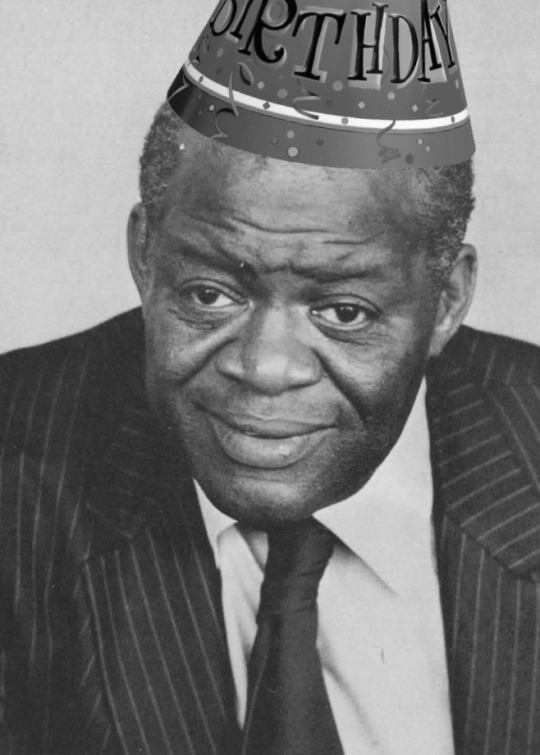
Happy birthday, Henry Winston! (April 2, 1911)
Chairman of the Communist Party of the United States from 1966 to 1986, Henry Winston was born to a poor Black family in Mississippi, growing up there and in Kansas City. Coming of age as the Great Depression began, Winston began his involvement with the CPUSA through its Unemployed Council in Kansas City. By 1936, he sat on the national board of the party as one of its leaders. As a result, Winston was targeted along with the rest of the CPUSA party leadership in the Second Red Scare, convicted of insurrection in the Smith Act trials. He spent some time in hiding after his conviction before surrendering himself to authorities and serving time in federal prison until his release in 1961 due to the Supreme Court's ruling in Noto v. United States. Winston wrote several theoretical works which connected the contemporary struggle of Black Americans for their rights with the socialist cause, and he was also active in efforts to pressure the American government to end support for Apartheid South Africa. He died in 1986.
"The giant industrial monopolies, the big banks and insurance companies, the financiers and landowners, all spawn racism and use it as one of their chief class weapons to maintain and defend their regime of exploitation and oppression, of enmity among peoples, of imperialist wars of aggression."
191 notes
·
View notes
Text
i need everyone who wears a foil hat for s5 theories to gather around, sissy zig has a story to tell (a theory) (i’m so delusional pls just humor me)
as we have all seen, there is more than likely a time jump in s5. BUT WHEN is it taking place? in episode 1? are they filming out of sequence? (not uncommon) ALTHOUGH Cara Buono (Karen Wheeler) gave a small “interview” if you will— saying they were filming episode two.
Anyway,

ross duffer shared this on instagram.
A Wrinkle In Time. and a simple wikipedia search will show that:

travel through space and time — intruded into several worlds. and don’t get me started on the rescue part.
now.
here is some general background information that we already know about Henry Creel:
has psychokinetic abilities
killed his mother and sister
was sent to Hawkins Lab with Brenner
his dad was accused of the murders
But. What happened before this?
According to the play, Stranger Things: The First Shadow
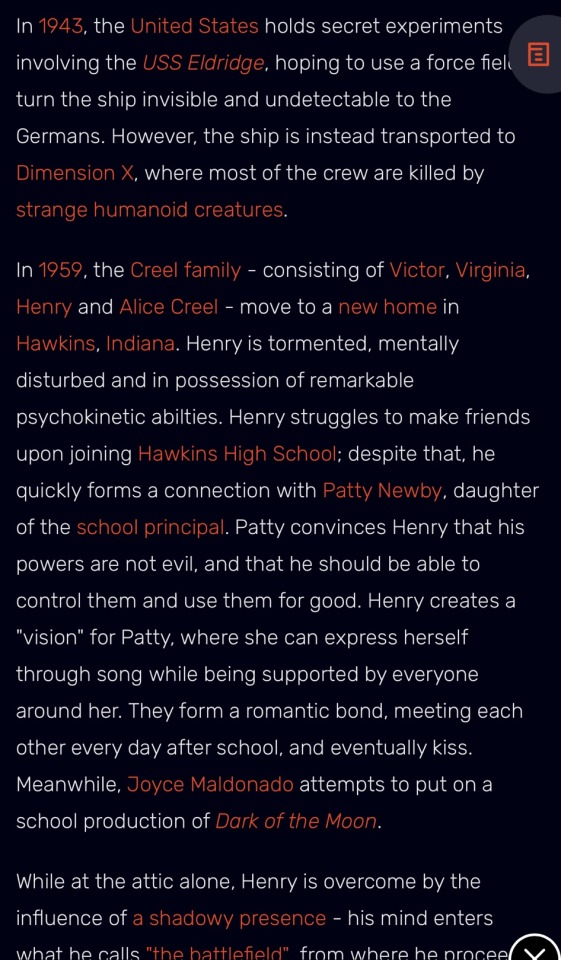
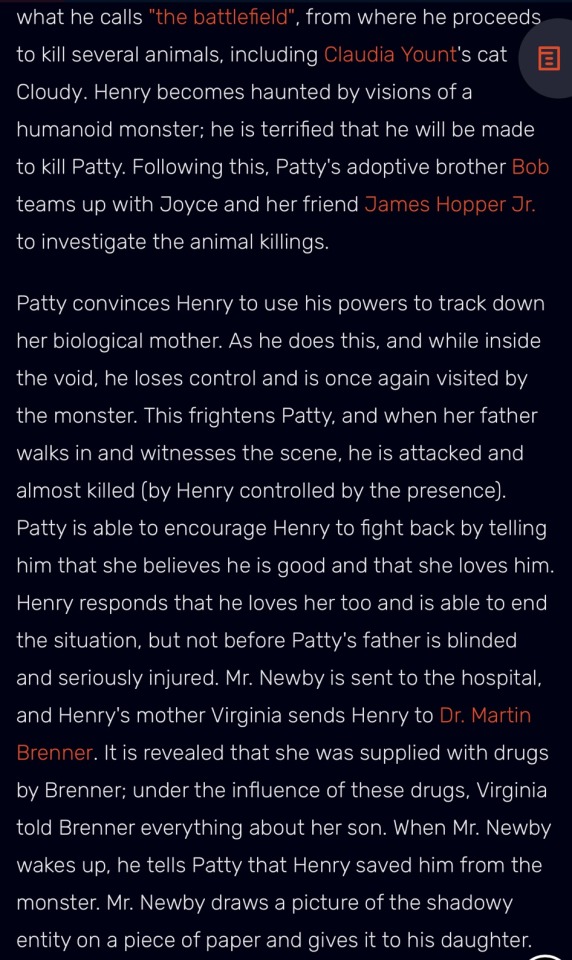



with this remember that the Upside Down was stuck in 1983, the day Will Byers went missing.
Along with the grandfather clock being a pretty key item in S4, is it safe to assume that Vecna can control/manipulate time?
Now, let’s look at the Kas Theory (my favorite)
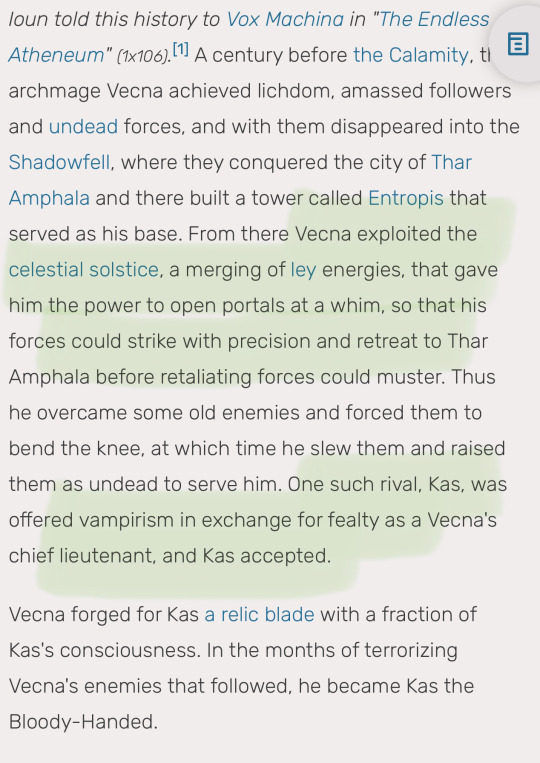
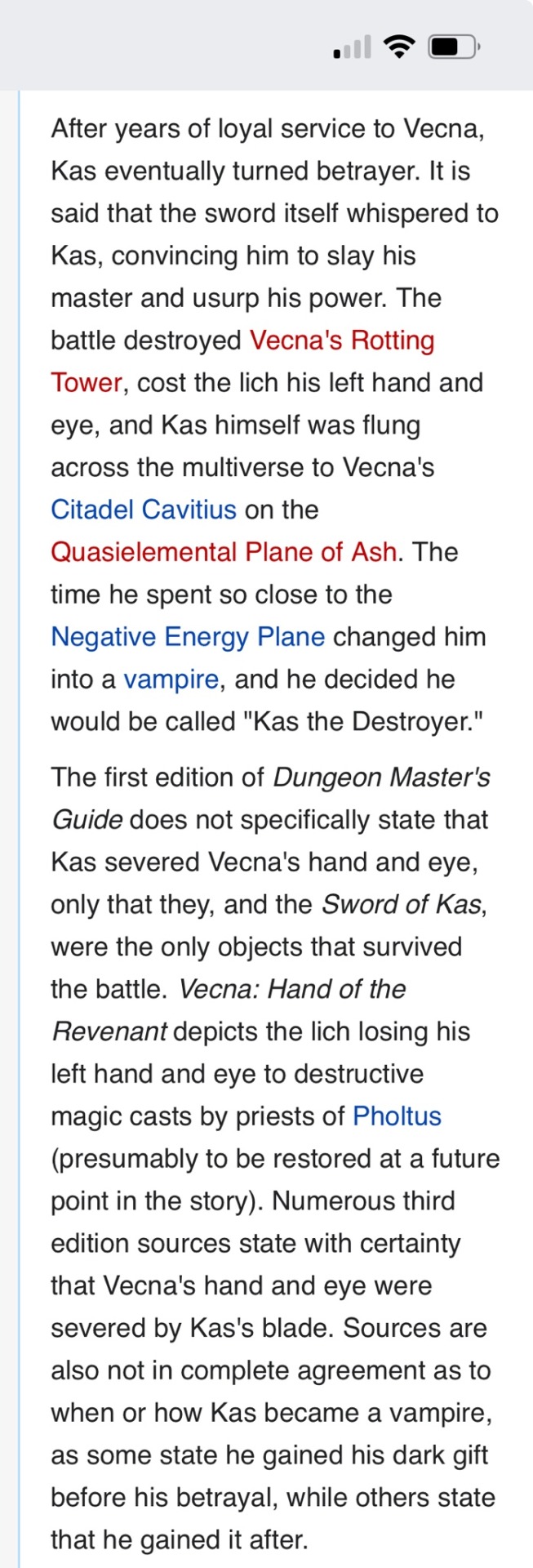

Above it states that Kas served under Vecna for years, so if the upside down is stuck in 1983, and Eddie was never taken from there.. but S4 ended in 1986, by means of the upside down.. Kas could have been “serving” his time with Vecna for years by the time they entered Hawkins. (possibly idk)
or
If the time jump is to 1989, Vecna and Kas could be lying in wait, preparing to make their second comeback. Will himself said Vecna was weak, and he would probably need time to build his undead army.
BACK TO, A Wrinkle In Time.


!!!

27 notes
·
View notes
Text
Happy Christmas Eve! Have a ficlet about Eddie terrorising Steve's parents. I had this half-written for @unclewaynemunson's Advent Calendar but I never finished it in time for a prompt
'Christmas Jailbreak, 1986'
"Harrington residence," Steve answers, his phone-voice up-ticking like it does at work. "Steve speaking."
"Oh good, it is you," comes Eddie's cheerful voice before pivoting to comical seriousness as he adds, "Meet me in your bedroom in fifteen minutes."
The line goes dead. Steve frowns, holding the kitchen phone as he mother rushes past with a roast. He rolls his eyes at her ridiculous dress, green with a big red bow at the front that matches with the Christmas decorations.
By the time Steve finally gets to his bedroom, it’s been at least half an hour. Immediately after the movie-like cold call from his boyfriend, Steve was instructed by his mother to serve drinks as Christmas dinner was ready. As always her tone had a sense of urgency laced with disappointment that he wasn't the perfect host like she was. Meanwhile his father sat at the head of the table like the King Douchebag he was, regaling his grandmother and great aunt Doris with boring work tales and doing fuck-all else.
Eddie is just there waiting, clad in black as always, with snow kissed cheek and misty hair laying back on the freshly ironed plaid bedspread, flicking through a Playboy. Just like he would do any time he was waiting for Steve to finish his nightly hair routine and come to bed. Something he hadn't been able to do since before Thanksgiving, all because Mr and Mrs Neglectful-And-Emotionally-Inept were actually residing over their kingdom for once.
Steve rushes over and snatches the magazine from him, throwing it clean under his bed.
"Hey! I was reading that!"
Steve shushes him before grinning, "No, you weren’t."
"So you don’t buy it for the articles then?" he teases, straightening up and smiling, dimples on full display.
Steve leans down and kisses him.
"I’ve missed you," he says, sadder than he'd intended as he runs his hand up Eddie’s arm suggestively.
"Came to save you from your Christmas nightmare fortress, Rapunzel," he smiles,pecking him on the cheek. "Or crash this thing and terrorise your parents. Take your pick."
"Fuck it," Steve smiles.
He was all ready to go live with Eddie and Wayne in their new trailer anyway when his parents left again. They'd planned on going away for New Year's but Steve thinks they might go the second they shove the oldies out the door, so what was the difference of perhaps mere hours?
"Your getaway chariot awaits, princess," Eddie says, rolling off the bed and taking a bow. "Are you giving me full permission to wreck the Harrington Christmas Dinner?"
"What can I say, I’m in the festive spirit," he says through laughs as Eddie bear-hugs him. "Just don’t do anything that will make my dad call the cops."
Eddie pulls away and mock gasps as he clutches his chest. "Never, Stevie."
Wasting no time, Steve slings his overnight bag over his shoulder, rolls his nail bat from under the bed, tucks Eddie’s Christmas present under his arm.
"Uh-oh…" Eddie soon gulps, looking beyond Steve to the bedroom door. And there she is, his mother. Looking into the room with the same disgusted expression she had on the countless occasions she’d walked in on Steve making out with a girl.
"What the hell is going on in here?" she demands, practically clutching at the door frame as she recoils away from Eddie.
"Hi, Mrs Harrington," Eddie says, bowing.
As Steve makes for the bedroom door, he grabs Eddie’s hand and tugs him into the hall.
"Bye, Mom!"
"Like the dress, Mrs H!" Eddie calls behind them as they run down the stairs.
"John! That Munson boy is in our house!" Mrs Harrington shrieks from upstairs as they reach the bottom of the staircase.
Steve catches a glimpse of his father, sitting like the douchebag king he is at the head of the dining table.
"Steven!"
Steve looks at Eddie, shrugs and gives a smirk. Eddie chews at his bottom lip for a second and cranes his neck to peek into the dining room.
"What are you doing?" his father demands. Steve can tell he is willing himself not to shout in front of guests. "What is your mother shouting about?"
Steve snorts a laugh. Of course, his father wasn't even listening, despite his mother positively screaming upstairs.
"Oh," Eddie says, a devilish smile creeping across his face as he dramatically tiptoes towards the dining room. "This is Mr Harrington."
Steve's grandma and great-aunt sit in stunned silence as the young man dressed in leather rounds the table to stand beside John Harrington’s seat at the head of the table as Steve stands in the archway.
"Don’t tell Mrs H but, I’ve been in your house a lot, Johnny Boy."
As he passes Doris, he leans forward and picks up her crystal aperitif glass. He chugs it, a little red liquid spilling from his mouth as he grimaces. He wipes his mouth with the back of his hand before flicking it, probably hoping for a permanent red spot on the cream carpet.
"Yuck, sherry," he says with a theatrical shiver before leaning down to whisper in a terrified Doris’ ear, "Tastes cheap too."
Steve barks out a laugh, knowing his mother buys the bottom-shelf stuff for Doris, but promptly covers his mouth as he catches his father’s furious eye.
"Weren’t you in prison?" John asks, side-eyeing Eddie and leaning away as if to avoid any potential physical contact.
"Nah," he says looking over the elaborate table and pursing his lips in thought. "The Satanic murder charges didn’t quite stick. Thanks to your son, actually."
Eddie winks at Steve and now his father truly looks confused. They stare at each other for a moment and soon Steve swears he sees the moment a light bulb goes off in his father’s head. He leans forward with a warning finger at his son. He merely shrugs as John’s eyes narrow.
Eddie plucks a baked potato directly off his plate as Mr Harrington stares at Steve’s nailed baseball bat.
"Jesus Christ!" Steve says, amazed at the show and entirely forgetting that he is literally fleeing his home hand-in-hand with his boyfriend.
"Son!" his father warns before forcing an unconvincing smile. "Get this idiot out of here."
Steve shrugs again. He guesses he’ll intervene if he absolutely, one hundred percent needs to. But in the meantime…
Eddie licks the potato and places it back on John’s plate, making sure to smear it thoroughly through the obscene serving of gravy. He picks up another, examining it.
"So many things I want to say…" Eddie says, goading as he looms over John, who’s leaning so far away that Steve is sure he’ll topple off his chair at any moment. "... But I won’t. Come on."
He tugs on Steve’s arm as he chomps down on as much of the potato as he can get in his mouth in one bite. They exit the dining room, leaving murmurs and a bristling John Harrington behind.
"Moving in with Eddie, bye!" Steve says rapidly as he passes his mother standing at the foot of the stairs, white-knuckling the bannister.
"The potatoes are great, Mrs H!" Eddie calls, potato-spittle flying out of his mouth.
"Charming introduction," Steve laughs as they walk out the front door.
Eddie continues chewing and eventually swallows with a struggling gulp.
"Parents love me," he chokes. "Should I go back in and get on the table?"
#hating steve's parents: christmas edition#writing eddie terrorising steve's parents is a self-indulgent christmas present to myself#if this is carppily edited whoops im kinda drunk#steddie#steve harrington#eddie munson#steddie ficlet#steddie christmas#lilys ficlets#harrington family TM
328 notes
·
View notes
Text
If the "infertility epidemic" was the first round of fire in the pronatal campaign of the '80s, then the "birth dearth" was the second. At least the leaders of this campaign were more honest: they denounced liberated women for choosing to have fewer of no children. They didn't pretend that they were just neutrally reporting statistics; they proudly admitted that they were seeking to manipulate female behavior. "Most of this small book is a speculation and provocation," Ben Wattenberg freely concedes in his 1987 work, The Birth Dearth. "Will public attitudes change soon, thereby changing fertility behavior?" he asks. "I hope so. It is the root reason for writing this book."
Instead of hounding women into the maternity ward with now-or-never threats, the birth dearth theorists tried appealing to society's baser instincts—xenophobia, militarism, and bigotry, to name a few. If white educated middle-class women don't start reproducing, the birth-dearth men warned, paupers, fools, and foreigners would—and America would soon be out of business. Harvard psychologist Richard Herrnstein predicted that the genius pool would shrink by nearly 60 percent and the population with IQs under seventy would swell by a comparable amount, because the "brighter" women were neglecting their reproductive duties to chase after college degrees and careers—and insisting on using birth control. "Sex comes first, the pains and costs of pregnancy and motherhood later," he harumphed. If present trends continue, he grimly advised, "it could swamp the effects of anything else we may do about our economic standing in the world." The documentation he offered for this trend? Casual comments from some young students at Harvard who seemed "anxious" about having children, grumblings from some friends who wanted more grandchildren, and dialogue from movies like Baby Boom and Three Men and a Baby.
The birth dearth's creator and chief cheerleader was Ben Wattenberg, a syndicated columnist and senior fellow at the American Enterprise Institute, who first introduced the birth dearth threat in 1986 in the conservative journal Public Opinion—and tirelessly promoted it in an endless round of speeches, radio talks, television appearances, and his own newspaper column.
His inflammatory tactics constituted a notable departure from the levelheaded approach he had advocated a decade earlier in his book The Real America, in which he chided population-boom theorists for spreading "souped-up scare rhetoric" and "alarmist fiction." The fertility rate, he said, was actually in slow decline, which he saw then as a "quite salutary" trend, promising more jobs and a higher living standard. The birth dearth, he enthused then, "may well prove to be the single most important agent of a massive expansion and a massive economic upgrading" for the middle class.
Just ten years later, the fifty-three-year-old father of four was sounding all the alarms about this "scary" trend. "Will the world backslide?" he gasped in The Birth Dearth. "Could the Third World culture become dominant?" According to Wattenberg's treatise—subtitled "What Happens When People in Free Countries Don't Have Enough Babies"—the United States would lose its world power status, millions would be put out of work, multiplying minorities would create "ugly turbulence," smaller tax bases would diminish the military's nuclear weapons stockpiles, and a shrinking army would not be able “to deter potential Soviet expansionism.”
When Wattenberg got around to assigning blame, the women's movement served as the prime scapegoat. For generating what he now characterized as a steep drop in the birthrate to "below replacement level," he faulted women's interest in postponing marriage and motherhood, women's desire for advancing their education and careers, women's insistence on the legalization of abortion, and "women's liberation" in general. To solve the problem, he lectures, women should be urged to put their careers off until after they have babies. Nevertheles, he actually maintains, "I believe that The Birth Dearth sets out a substantially pro-feminist view."
Wattenberg's birth dearth slogan was quickly adopted by New Right leaders, conservative social theorists, and presidential candidates, who began alluding in ominous—and racist—tones to "cultural suicide" and "genetic suicide." This threat became the subject of a plank in the political platforms of both Jack Kemp and Pat Robertson, who were also quick to link the fall of the birthrate with the rise in women's rights. Allan Carlson, president of the conservative Rockford Institute, proposed that the best way to cure birth dearth was to get rid of the Equal Pay Act and federal laws banning sex discrimination in employment. At a 1985 American Enterprise Institute conference, Edward Luttwack went even further: he proposed that American policy makers might consider reactivating the pronatal initiatives of Vichy France; that Nazi-collaborationist government's attack on abortion and promotion of total motherhood might have valuable application on today's recalcitrant women. And at a seminar sponsored by Stanford University's Hoover Institution, panelists deplored "the independence of women" for lowering the birthrate and charged that women who refused to have many children lacked "values."
These men were as anxious to stop single black women from procreating as they were for married white women to start. The rate of illegitimate births to black women, especially black teenage girls, was reaching "epidemic" proportions, conservative social scientists intoned repeatedly in speeches and press interviews. The pronatalists' use of the disease metaphor is unintentionally revealing: they considered it an "epidemic" when white women didn't reproduce or when black women did. In the case of black women, their claims were simply wrong. Illegitimate births to both black women and black teenagers were actually declining in the '80s; the only increase in out-of-wedlock births was among white women.
-Susan Faludi, Backlash: the Undeclared War Against American Women
#susan faludi#amerika#pronatalism#anti choice rhetoric#racism#sexism#the more things change the more they stay the same
31 notes
·
View notes
Text

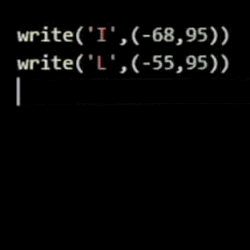




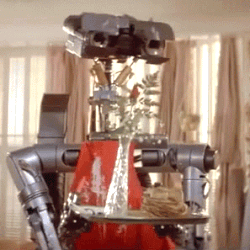


Johnny 5 (Short Circuit 1986) Stimboard (for the very sweet Anon who requested I make a stimboard with lovecore & one of my favourite characters)
x x x / x x x / x x x
[Image description: a 9 gif stimboard; from left to right.
First line: A gif of a heart made with a circuit board and LEDs, the LEDs light up in different sequences. A gif of a cropped pc screen where program code is being written (to create a python graphic that says 'I love you'). And a gif of Johnny 5 from the film Short Circuit, the robot is wearing a red apron and carrying a little serving tray with a flower in a vase, a glass of orange juice and a stack of pancakes.
Second line: A gif of a 3d printed heart with a flashing LED light and moving/spinning gears, a large wheel-shaped lid opens up at the back to reveal metal inside. A gif of Johnny 5 wearing an apron and looking at a cook book while baking in a kitchen. And a gif of the monitor of an oscilloscope machine, someone is using an Arduino to create a flickering outline of a heart on the screen.
Third line: A gif of Johnny 5, the robot is wearing a red apron and carrying a little serving tray with a flower in a vase and a stack of pancakes. A gif of a heart made with a circuit board and LEDs, the LEDs light up in different sequences. And a cropped gif of a pc screen where someone uses a code to make a heart shape graphic appear little by little.
End of image description.]
#this was so sweet thank you Anon#I wasn't sure who to do but he popped into my head#stimboard#lovecore#hearts#flashing#circuit board#mechanical#electronics#coding#computers#typing#gears#rotating#robotics#food
19 notes
·
View notes
Text
the weird creel timelines- an initial post (if you’re wondering what all the timeline talk is about lately, read this)
Alright, so, I started this post a few weeks ago but didn’t finish it until now, and it was originally a reblog on this post from @bylerschmyler and basically this is where all the timeline stuff with the Creels that I’ve been talking about lately originated from (and what @henrysglock and I have been ranting about.)
This is not the full Creel timeline analysis, just the initial post, and because it’s fairly old at this point, there’s more I’ve come up with that adds to it. I’m currently working on putting together the full timeline analysis. But, for now, let’s get into that intial post:
So, part of this depends on whether or not you believe in the 8flix scripts (personally I think they’re completely real and that there’s firm evidence to back this up), but I still have the scripts in my email, so I went and took a look at the “Dear Billy,” script. And I found some weird things. And then I went and looked at the newspaper articles again- and I found even more weird things.
First of all, it’s weird that the Creels are said to be moving into the house in March of 1959- the exact same year and month that the Creel murders are said to have occurred in the show/in the newspaper, which makes it seem like they only lived there for a month.

Second of all, in the script, Alice and Virginia are briefly swapped. We'll come back to this later. Victor puts his arm around “Alice,” rather than Virginia.
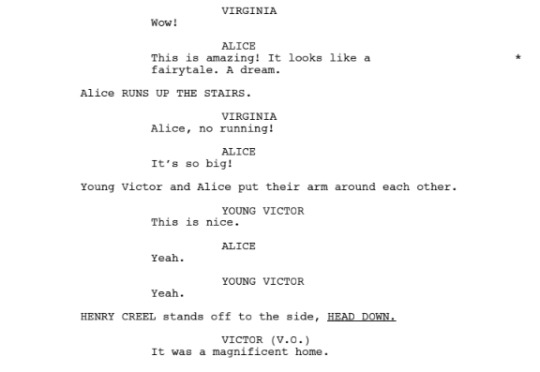
As well, as mentioned earlier, the murders are listed as occurring on March 25th 1959, but as I mentioned in this post, that’s extremely different than what the Indianapolis Gazette says.
March 25th 1959 was a Wednesday. Meanwhile, in the Indianapolis Gazette, the Creel murders are said to have happened on Saturday, March 21st and the bodies were discovered on Sunday, March 22nd when Victor was found wandering along the side of the road and escorted back home by Hawkins Police officers.
So, the dates listed here are directly contradictory to some of the newspaper articles in the show, something I'm going to really dive into here in a bit.
I talked in another post about the fact that it’s extremely likely that the lab altered Victor’s memories- and now Victor’s “one month of peace,” comment is looking even more suspicious because according to the script, the Creels moved into the house in March of 1959, but then the murders, according to the script, occurred on March 25th 1959, and Victor was in prison in early April of 1959.
I think that Victor, as of 1986, might legitimately believe that they only lived there for a month. This would track with the lab having messed with his memories, and it would explain why SO many details that are in the newspapers (such as Victor calling an exorcist) are absent from his retelling. However, like I’m going to dig into, I also think that there’s timeline weirdness at play here, and I think that “timeline weirdness” and “Victor’s memories have been messed with can coexist, especially since (and this is going to make no sense rn but will later in this analysis), it Might imply that the “Dear Billy” script timeline and the Weekly Watcher timeline are the same timeline, but the Dear Billy timeline is warped by Victor’s messy memories. However, this is something I’m still not certain of, so take it with a grain of salt.
And regarding the newspapers vs the scripts, I know there’s been lots of talk of Henry’s age and Alice’s age, but what about Victor’s age?
The “Dear Billy,” script puts his age being 40 in 1959 and 67 in 1986.
Now, look at this newspaper clipping from the Indianapolis Gazette:
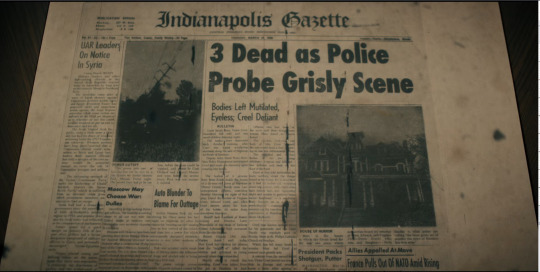
Victor is listed as being 35 years old as of 1959.

“The bodies of 3 persons have been found inside the home of a 35-year-old Town of Hawkins Roane County family man.”
This same paper also talks about Victor serving two tours in WW2.

“A veteran from the second world war, Victor Creel served two tours of duty in Europe and returned home a hero.”
It’s also the same paper that talks about the Creels living in Hawkins for two years.

"Here is the house in which the Creels lived for the last two years where-"
It’s ALSO the SAME paper that mentions “Edward Creel,” and names Alice as Victor’s wife and Virginia as his daughter.

“-authorities found the remains of Alice, Edward, and Virginia Creel- Victor Creel’s wife, son, and daughter.”
Virginia is also listed as one of the children earlier in the article, and there’s no Henry in this article, only Edward.

"The mangled and eyeless bodies of the two young children- Virginia and Edward- laid deflated and bent on the floor of the foyer."
And this is ALSO the same paper that claims that Alice, Henry (named as Edward in this article, the name ‘Henry,’ does not appear in this article at ALL), AND Virginia were all found dead in the foyer- Virginia wasn’t at the table, according to this article.
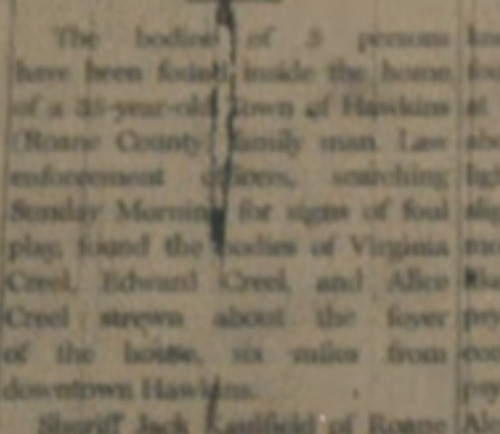
"Law enforcement officers searching Sunday Morning for signs of foul play found the bodies of Virginia Creel, Edward Creel, and Alice Creel strewn about the foyers of the house, six miles from downtown Hawkins."
However, possibly contrary to the above, the same article lists only Henry/Edward and Virginia (who is listed as Victor's daughter) as being in the foyer, and makes no mention of where "Mrs Creel's" body was found, and instead, just talks about her body being butchered like a deer.
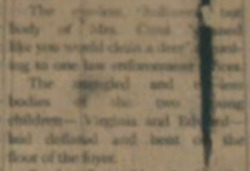
“The eyeless, mutilated dead body of Ms Creel “butchered like you would clean a deer,” (???) to one law enforcement (???)”
So, let’s regroup- how many possible timelines do we have based on the show, the scripts, and the newspapers? First, let's look at some key information/our sources.
Looking At Individual Sources

The Indianapolis Gazette
According to the Indiapolis Gazette:
Victor was 35 in 1959. This would make him born in 1921.
The murders occured Saturday night on March 21st 1959
The Creels lived in Hawkins for two years/moved to Hawkins two years prior to 1959, putting their move-in date as 1957.
There is nobody named "Henry Creel" in this article. Only "Edward Creel."
No ages are listed for Alice, Henry/Edward, or Virginia.
Alice is listed as Victor's wife repeatedly, and Virginia is listed as his daughter repeatedly. Edward is listed as Victor's son. Henry does not exist.
Victor did two tours in Europe during the war and was a war hero. I'm not 100% sure how long a tour is, but doing a quick bit of research, a tour in WW2 seems to have been 365 days/a year, meaning that Victor was at war for 2 years. There is no return from war date listed for Victor, nor is it listed when he was at war, simply that he was at war for two years.
This newspaper is listed as being published on Thursday, March 26th, 1959.

The Weekly Watcher
According to the Weekly Watcher:
Victor is listed as being 40 in 1959. This would make him born in 1919.
The Weekly Watcher makes no clear note of what date the murders happened on.
The Weekly Watcher makes no clear note of how long the Creels lived in Hawkins, and also does not make any clear note of when they moved to Hawkins. However, there's details such as the groundsperson and the gardener working at the Creel house that seem to indicate that they lived there for a fair while.
Henry is present in this article. There is no "Edward Creel" in this article.
Alice is listed as being 15 in 1959, Henry is listed as being 12 in 1959, and Virginia is listed as being 36 in 1959.
Virginia is listed as Victor's wife, and Henry and Alice are listed as Victor's two children.
There is no mention of how long Victor was in the war, nor is it mentioned when he was in the war nor is a return from war date mentioned for Victor.
This newspaper is listed as being published on March 26th, 1959.

8flix Dear Billy Script
According to the Dear Billy script:
Victor is listed as being 40 in 1959 and 67 in 1986. This would make him born in 1919.
The murders occured on March 25th, 1959.
The Creels lived in Hawkins for under a month and moved into the house in March of 1959. Although there's an exact day for the murders, the exact day for the move-in is suspiciously absent.
Henry is present in the script. There is no "Edward Creel," in this script.
Alice is listed as being 15 in 1959, Henry is listed as being 12 in 1959, and Virginia is listed as being 36 in 1959.
Virginia is listed as Victor's wife and Henry and Alice are listed as Victor's two children. However, this is later contradicted when Alice is swapped for Virginia during scenes/lines during the moving in segment, but they are not swapped for the entire script.
Victor was in France in 1944 but had also been back from the war for 14 years as of 1959. This would put him as returning from the war in 1945. However, it does not mention how long Victor was at war.
This is a script and doesn't have a publication date like the newspapers do.

Comparing Sources
So, what information can we pull from all this? Let's compare all of our sources and see
A.) what information do they have in common?
B.) what information is different?
C.) what information is missing entirely?
Let's start with A.)

A.) What Do All of These Sources Have in Common?
Weekly Watcher and Indianapolis Gazette Similarities
The Weekly Watcher does not mention a return from war date for Victor. The Indianapolis Gazette also does not mention a return from war date for Victor.
Weekly Watcher and Dear Billy Script Similarities
The Weekly Watcher lists Victor as 40 years old in 1959. The Dear Billy script lists Victor as 40 years old in 1959. Both of these would make Victor born in 1919.
The Weekly Watcher does not mention Edward Creel and does mention Henry Creel. The Dear Billy script does not mention Edward Creel and does mention Henry Creel.
The Weekly Watcher lists Alice is as being 15 in 1959, Henry is listed as being 12 in 1959, and Virginia is listed as being 36 in 1959. The Dear Billy script lists Alice as being 15 in 1959, Henry is listed as being 12 in 1959, and Virginia is listed as being 36 in 1959.
The Weekly Watcher lists Virginia as Victor's wife, and Henry and Alice are listed as Victor's two children. The Dear Billy script lists Virginia as Victor's wife and Henry and Alice are listed as Victor's two children. HOWEVER, this is ALSO a difference because the Dear Billy script ALSO briefly swaps Alice and Virginia.
The Weekly Watcher does not list how long Victor was at war for. The Dear Billy script also does not list how long Victor was at war for.
Indianapolis Gazette and Dear Billy Script Similarities
The Indianapolis Gazette lists Alice as Victor's wife and Virginia as Victor's daughter, swapping them. The Dear Billy script also briefly swaps them, although it ALSO lists them properly/Alice as the daughter and Virginia as the wife.
Similarities Between All Three Sources
Based on the list of criteria I've been using throughout, there are no similarities that are the same between all three sources except for the murders happening in 1959, which is a given and isn't part of the criteria.
B.) What Is Different Between All These Sources?
Weekly Watcher and Indianapolis Gazette Differences
The Weekly Watcher lists Victor as 40 years old in 1959, whereas the Indianapolis Gazette lists Victor as 35 years old in 1959.
The Weekly Watcher mentions Henry Creel, whereas the Indianapolis Gazette mentions Edward Creel
The Weekly Watcher lists Henry as 12 in 1959, Alice’s age as 15 in 1959. and Virginia’s age as 36 in 1959. The Indianapolis Gazette does not list the ages of Edward, Alice or Virginia.
In the Weekly Watcher, the date of the Creel murders is not listed, at least not from what’s visible in this article. In the Indianapolis Gazette, the date of the Creel murders is Saturday, March 21st, 1959.
In the Weekly Watcher, the length of time that the Creels lived in Hawkins is not listed from what we can see in this article, however, information regarding the exorcism and the groundskeeper and gardener seems to imply that the Creels lived in Hawkins for at least some sizeable length of time. In the Indianapolis Gazette, the Creels lived in Hawkins for two years prior to 1959.
In the Weekly Watcher, the Creels’ move-in date is not listed, at least not from what’s visible in this article. IIn the Indianapolis Gazette, no move-in month or day is listed, but they moved to Hawkins in 1957.
In the Weekly Watcher, Alice is Victor’s daughter and Virginia is Victor’s wife. In the Indianapolis Gazette, Alice is Victor’s wife, and Virginia is Victor’s daughter.
In the Weekly Watcher, the length of time that Victor was at war is not mentioned. In the Indianapolis Gzette, Victor was at war for two tours, seemingly two years.
Weekly Watcher and Dear Billy Script Differences
The Weekly Watcher does not list the date of the Creel murders, whereas the Dear Billy script lists their date as March 25th, 1959.
The Weekly Watcher does not list the Creel’s move-in date, at least not from what’s visible in this article. In the Dear Billy script, the Creels moved to Hawkins in March of 1959. The exact day is not listed.
In the Weekly Watcher, the length of time that the Creels lived in Hawkins is not listed from what we can see in this article, however, information regarding the exorcism and the groundskeeper and gardener seems to imply that the Creels lived in Hawkins for at least some sizeable length of time. In the Dear Billy script, the Creels lived in Hawkins for under a month, moving to Hawkins in March of 1959 and the murders also occurring in March of 1959.
In the Weekly Watcher, it is unknown when Victor went to war. In the Dear Billy script, Victor was at war during 1944.
In the Weekly Watcher, it is unknown when Victor returned from war. In the Dear Billy script, Victor seems to have returned from war in 1945, as in the script in 1959, he mentions being home from the war for 14 years.
Indianapolis Gazette and Dear Billy Script Differences
The Indianapolis Gazette lists Victor as 35 years old in 1959, wheraas the Dear Billy script has him as 40 years old in 1959.
The Indianapolis Gazette mentions Edward Creel, whereas the Dear Billy script mentions Henry Creel.
The Indianapolis Gazette does not list the ages of Edward, Alice or Virginia. The Dear Billy script presents that Henry is 12 as of 1959, Alice is 15 as of 1959, and Virginia is 36 as of 1959.
The Indianapolis Gazette says that the Creels moved to Hawkins in 1957, whereas the Dear Billy script has them moving to Hawkins in March of 1959.
The Indianapolis Gazette says that the Creels lived in Hawkins for two years. The Dear Billy script says that the Creels lived in Hawkins for under a month, moving to Hawkins in March of 1959 and the murders also occurring in March of 1959.
In the Indianapolis Gazette, Alice is Victor’s wife, and Virginia is his daughter. In the Dear Billy script, Alice is Victor’s daughter, and Virginia is his wife, HOWEVER, they DO swap places briefly in the Dear Billy script.
In the Indianapolis Gazette, Victor was at war for two turns. The Dear Billy script does not list how long Victor was at war for.
The Indianapolis Gazette does not say when Victor was at war. The Dear Billy script says that he was at Normandy in 1944
The Indianapolis Gazette does not say when Victor returned home from war. The Dear Billy script says that Victor seems to have returned from war in 1945, as in the script in 1959, he mentions being home from the war for 14 years.

C.) What Information is Missing?
What's Missing from the Weekly Watcher?
The date of the murders
The date that the Creels moved to Hawkins and exactly how long they liived in Hawkins.
How long Victor was in the war
When Victor was in the war
When Victor returned from war
What's Missing from the Indianapolis Gazette?
Alice’s age, Virginia’s age, and Henry/Edward’s age
When Victor was in the war.
When Victor returned from war.
What's Missing from the Dear Billy Script?
The exact day that the Creel family moved to Hawkins.
How long Victor was at war.

Summarizing The Similarities and Differences And Doing A Category-By-Category Comparison
To summarize the similarties and differences between the sources and the missing info, let’s go category-by-category rather than source-by-source to make it clearer:

Category 1: Victor’s Age and Birth Year
Indianapolis Gazette: As of 1959, Victor’s age is 35, making his birth year 1924.
Weekly Watcher: As of 1959, Victor’s Age is 40, making his birth year 1919.
Dear Billy Script: As of 1959, Victor’s age is 40, making his birth year 1919.
TLDR: Victor’s age is the same between the Weekly Watcher and Dear Billy but confirmed to be different in the Gazette.

Category 2: Date of the Creel Murders
Indianapolis Gazette: The date of the Creel murders is Saturday, March 21st, 1959.
Weekly Watcher: The date of the Creel murders is not listed, at least not from what’s visible in this article.
Dear Billy Script: The date of the Creel Murders is Wednesday, March 25th, 1959.
This isn’t technically the same between all of them, but it’s also not different between all of them because the Weekly Watcher is simply unknown, not confirmed as a separate third date.
TLDR: The date of the Creel Murders is different between the Indianapolis Gazette and Dear Billy script, and unconfirmed in the Weekly Watcher.

Category 3: Creel Move-In Date
Indianapolis Gazette: The Creels moved to Hawkins in 1957, day and month unknown.
Weekly Watcher: The Creels’ move-in date is not listed, at least not from what’s visible in this article.
Dear Billy Script: The Creels moved to Hawkins in March of 1959. The exact day is not listed.
Just like the murder date, this isn’t the same between all of them, but it’s also not technically completely different between all of them because the Weekly Watcher’s date is simply unknown, not confirmed as a separate third date.
None of the sources give an exact move-in day, and only Dear Billy gives a move-in month.
TLDR: The Creels’ move-in date is different between the Indianapolis Gazette and the Dear Billy script, and unconfirmed in the Weekly Watcher.

Category 4: How Long the Creels Lived in Hawkins
Indianapolis Gazette: The Creels lived in Hawkins for two years prior to 1959.
Weekly Watcher: The length of time that the Creels lived in Hawkins is not listed from what we can see in this article, however, information regarding the exorcism and the groundskeeper and gardener seems to imply that the Creels lived in Hawkins for at least some sizeable length of time.
Dear Billy Script: The Creels lived in Hawkins for under a month, moving to Hawkins in March of 1959 and the murders also occurring in March of 1959.
Just like the murder date and move-in date, this isn’t the same between all of them, but it’s also not technically completely different between all of them because the Weekly Watcher’s length of time is simply unknown, not confirmed as a separate third option.
TLDR: The length of time that the Creels lived in Hawkins is different between the Indianapolis Gazette and Dear Billy script, but unconfirmed in the Weekly Watcher.

Category 5: Is Henry or Edward present
Indianapolis Gazette: Edward is mentioned. Henry is not mentioned.
Weekly Watcher: Henry is mentioned. Edward is not mentioned.
Dear Billy Script: Henry is mentioned. Edward is not mentioned.
TLDR: The presence of Henry is the same between the Weekly Watcher and the Dear Billy script. but confirmed to be different in the Indianapolis Gazette

Category 6: Edward/Henry’s age and Virginia and Alice’s ages
Indianapolis Gazette: Henry’s age is not listed. Virginia’s age is not listed. Alice’s age is not listed.
Weekly Watcher: Henry is 12 as of 1959. Alice is 15 as of 1959. Virginia is 36 as of 1959.
Dear Billy Script: Henry is 12 as of 1959. Alice is 15 as of 1959. Virginia is 36 as of 1959.
This is the same between the Weekly Watcher and Dear Billy. However, because we don’t know the Weekly Watcher version of the Creels’ move-in date, specifically because we don’t know the year, we don’t know if the move-in date ages are different in the Weekly Watcher vs the Dear Billy script, as the Dear Billy script has Henry moving to Hawkins in 1959 and being 12 at the time, whereas the Indianapolis Gazette has the Creels and Edward moving to Hawkins in 1957 but lists no ages.
So, the ages as of 1959 are the same in the Weekly Watcher and Dear Billy, but the ages may not be the same for the move-in date.
TLDR: The ages of Henry, Virginia, and Alice are the same between the Weekly Watcher and Dear BIlly but unconfirmed in the Indianapolis Gazette. Edward’s age is never mentioned. Mom-Alice’s age is never mentioned. Sister-Virginia’s age is never mentioned.

Category 7: Who is Listed as Victor’s Wife vs Victor’s Daughter
Indianapolis Gazette: Alice is Victor’s wife and Virginia is Victor’s daughter.
Weekly Watcher: Alice is Victor’s daughter and Virginia is Victor’s wife.
Dear Billy Script: Alice is Victor’s daughter and Virginia is Victor’s wife.
TLDR: Victor’s wife and daughter are same between the Weekly Watcher and the Dear Billy script and confirmed to be different in the Indianapolis Gazette. HOWEVER, as mentioned earlier, the Dear Billy script also briefly swaps Virginia and Alice.

Category 8: How Long Was Victor At War?
Indianapolis Gazette: Victor was at war for two tours, seemingly two years.
Weekly Watcher: The length of time that Victor was at war is not mentioned
Dear Billy Script: The length of time that Victor was at war is not mentioned.
TLDR: This is unconfirmed in the Weekly Watcher and the Dear Billy script.

Category 9: When Was Victor At War?
Indianapolis Gazette: A date for Victor being at war is not outright confirmed AND Victor’s “I had been back from the war for 14 years” line is not present here (because it’s a newspaper), so, IF we apply that line here, he would’ve been at war in 1943 because in the Gazette timeline, the Creels moved to Hawkins in 1957, and 14 years prior to that would be 1943. However, because that line is not present in this source, we don’t know for sure if Victor had been home from the war for 14 years when moving to Hawkins in this timeline.
Weekly Watcher: There is no listed date for when Victor was at war.
Dear Billy Script: Victor was at war during 1944.
This is the same between the Indianapolis Gazette and the Weekly Watcher in the sense that neither has a confirmed date for when Victor was in the war, but the Gazette offers more insight than the Watcher does IF we apply info from other sources (Victor’s “14 years” line), because the Gazette gives us a move-in date whereas the Weekly Watcher does not.
However, both the Gazette and the Watcher technically don’t have confirmed dates for when Victor was in the war.
TLDR: When Victor was at war is unconfirmed in the Indianapolis Gazette and the Weekly Watcher and is confirmed in the Dear Billy script.

Category 10: When Did Victor Return From War?
Indianapolis Gazette: When Victor returned from the war is much like “when was Victor at war” when it comes to this source, because a date for Victor returning from war is not outright confirmed in the Gazette AND Victor’s “I had been back from the war for 14 years” line is not present here (because it’s a newspaper), so, IF we apply that line here, he would’ve returned from war in 1943 because in the Gazette timeline, the Creels moved to Hawkins in 1957, and 14 years prior to that would be 1943. However, because that line is not present in this source, we don’t know for sure if Victor had been home from the war for 14 years when moving to Hawkins in this timeline.
Weekly Watcher: There is no date for when Victor returned from the war.
Dear Billy Script: Victor seems to have returned from war in 1945, as in the script in 1959, he mentions being home from the war for 14 years.
This is the same between the Indianapolis Gazette and the Weekly Watcher in the sense that neither has a confirmed date for when Victor returned from the war war, but the Gazette offers more insight than the Watcher does IF we apply info from other sources (Victor’s “14 years” line), because the Gazette gives us a move-in date whereas the Weekly Watcher does not.
However, both the Gazette and the Watcher technically don’t have confirmed dates for when Victor returned from the war.
TLDR: When Victor returned from the war is unconfirmed in the Indianapolis Gazette and the Weekly Watcher but is confirmed in the Dear Billy script.

List of Current Possible Timelines
So, finally, here's a list of the initial possible timelines, based on what we know for certain from each source (again this is going to change and expand when I finish the main timeline analysis):

1.) The Dear Billy Script Timeline
Victor was 40 in 1959 and 40 when they moved to Hawkins.
The Creels lived in Hawkins for a month and moved there in March of 1959.
The murders occurred on Wednesday March 25th, 1959.
Alice was 15 in 1959 and 15 when they moved to Hawkins.
Henry was 12 in 1959 and 12 when they moved to Hawkins.
Virginia was 36 in 1959 and 36 when they moved to Hawkins.
There is no mention of Edward.
Victor got home from the war in 1945.
Victor was in Normandy/at war in 1944.
We don’t know how long Victor was at war/how long he served.
Victor messed up in France/Normandy and made the mistake of bombing civillians.
Virginia is Victor’s wife and Alice is Victor’s daughter, although this briefly swaps for one scene in the script.
Alice, being 15 in 1959, was born in 1944, a year before Victor even got home from the war. However, if Victor went to war in 1943, then Alice could’ve been conceived before he left, depending on when Victor went to war and what exact day Alice’s birthday was. However, in this source, we don’t know when Victor went to war.
Henry, being 12 in 1959, was born in 1947, two years after Victor got home from the war.

2.) The Indianapolis Gazette Timeline
Victor was 35 in 1959
The Creels lived in Hawkins for two years and moved there in 1957.
The murders occurred on on Saturday, March 21st 1959.
We don’t know how old Alice was in 1959, nor how old she was when they moved to Hawkins because even though we know when they moved to Hawkins, we don’t know how old Alice was in 1959 in this source.
We don’t know how old Virginia was in 1959, nor how old she was when they moved to Hawkins because even though we know when they moved to Hawkins, we don’t know how old Virginia was in 1959 in this source.
We don’t know how old Henry/Edward was in 1959, nor how old he was when they moved to Hawkins because even though we know when they moved to Hawkins, we don’t know how old Henry/Edward was in 1959 in this source.
Henry is not mentioned at ALL in this source.
We don’t know when Victor got home from the war.
We don’t know when Victor was at war/if he was in Normandy.
Victor was at war for “two tours”/served two tours.
Victor, interestingly enough, is listed as returning home as a war hero in the Gazette, which almost seems like it may contradict his massive blunder (the farmhouse and burning baby) that’s in the Dear Billy script.
Virginia is Victor’s daughter and Alice is Victor’s wife
Because we don’t know when Edward and Daughter-Virginia/”Alice” were born, AND because we don’t know when Victor was at war or when he returned home, we can’t compare their birth years to when Victor was at war.

3.) Weekly Watcher Timeline
Victor was 40 in 1959. We don’t know how old he was when they moved to Hawkins because we don’t know when they moved to Hawkins/how long they lived there.
We don’t know how long the Creels lived in Hawkins, nor do we know when they moved to Hawkins.
Alice was 15 in 1959, but we don’t know how old she was when they moved to Hawkins because we don’t know when they moved to Hawkins/how long they lived there.
Henry was 12 in 1959, but we don’t know how old he was when they moved to Hawkins because we don’t know when they moved to Hawkins/how long they lived there.
Virginia was 36 in 1959, but we don’t know how old she was when they moved to Hawkins because we don’t know when they moved to Hawkins/how long they lived there.
Edward is not mentioned at all.
We don’t know when Victor got home from the war.
We don’t know when Victor was at war/if he was in Normandy.
We don’t know when Victor returned from war.
Victor is not listed as a war hero, but his blunder in Normandy with the farmhouse/burning baby is also not mentioned. In fact, from what we can see of this article, Victor’s time in the war is simply not mentioned at all (granted there are two intro paragraphs that are too blurry to read).
Virginia is Victor’s wife and Alice is Victor’s daughter.
We know that Alice would’ve been born in 1944 in this timeline (as she was 15 in 1959) and that Henry would’ve been born in 1947 (as he was 12 in 1959), but we can’t compare that to when Victor was at war because we don’t know when Victor was at war, how long he was at war, OR when he returned home.

Normandy
This is where it ties into what bylerschmyler said in the post I linked in the very beginning, because if Victor came home from the war in 1943, how the hell was he in Normandy?
Like, Victor returning from the war in 1943 is reasonable enough on its own, as WW2 started in 1939, and so even when considering that Victor served “two tours,”/possibly two years in the war in the Indianapolis Gazette timeline, he could easily have returned home in 1943 if he went off to war in 1941.
But that doesn’t solve the Normandy problem, because a.) in the Dear Billy script, Victor’s time in Normandy is listed as 1944 and b.) that sort of conflict, as far as I can tell, wasn’t happening in Normandy with the USA in 1943.
But what if we take the idea of “Victor being at war in 1943,” and combine that with the fact that the Weekly Watcher makes no mention of Victor as a war hero, but also doesn’t mention his mistake in Normandy?
Almost like Victor wasn’t in Normandy at all, which solves the problem of Normandy and 1943.
However, it’s also worth keeping in mind that Victor’s time in the war, as far as I can tell, doesn’t seem to be mentioned in the Weekly Watcher at ALL.
So, what if there’s one timeline where Victor returned home disgraced (Dear Billy script), one where he was a war hero (Indianapolis Gazette), and one where he was never at war (Weekly Watcher)?
This would also track with the fact that the Indianapolis Gazette timeline doesn’t tell us when Victor was at war (just that he served two tours at some point)- meaning that he may not have been in Normandy in 1944, at all, meaning that his mistake with the farmhouse may not have happened, allowing him to return home a hero.
Which, that’s interesting to me, because Victor’s war trauma/mistake is implied to be something that Henry seemed rather upset about (assuming that Henry was even the one showing Victor the vision during the cradle scene, and assuming that the thing that made Victor Not a “good, normal person,” was his war mistake), so I wonder if it’s the sort of thing he’d try to erase by turning back time? By either making his father a hero or not making him go to war at all?
The Massacre at Hawkins Lab Script
Also, all of this gets even WEIRDER when we look at the “Massacre at Hawkins Lab,” script, which is NOT from 8flix and was released by ST production. It gets even weirder because there’s not a single date to be found when it comes to the Creel murders. At all. None.
There’s no move-in date.

There’s no date for the murders.
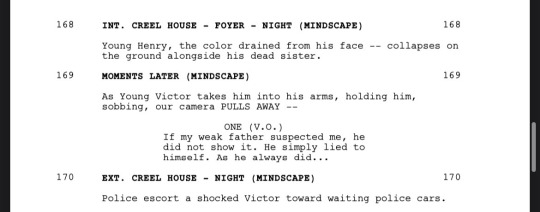
Nothing.
What the hell is going on here? IMO, this has Hawkins Lab and memory fuckery written all over it AND timeline fuckery most of all, especially since we still don’t know what Young Henry was doing with that clock.
And speaking of that clock scene- remember how I mentioned earlier that Alice and Virginia got swapped during part of the move-in scene in the Dear Billy script (and are also swapped in the Indianapolis Gazette article)? Well, they're not the only ones who got swapped in the script:

"Young Victor" walks over to the grandfather clock in the script, despite the fact that we see Young Henry walk over to it in the show. If it was just this error, I would dismiss it as an unintentional typo, but considering how Alice and Virginia swap places not only in the script, but also in the Indianapolis Gazette article, and how Henry isn't even present in that article, I'm not so sure about dismissing it as a simple error anymore.
Especially considering the theme of swapping places in ST with "Running Up That Hill," and also the fact that the scene of Henry staring at the clock has a really interesting shot setup. It's interesting because we never see through Nancy's eyes in this scene. They've put Nancy into this scene to give us an extra POV, and yet, we don't see through her eyes at all in this part. Was she even seeing Henry? Or was she seeing somebody else? Victor, perhaps?
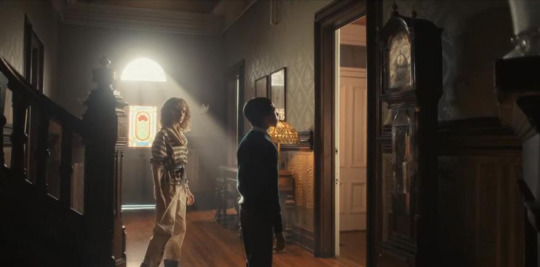

I don’t think it was particularly likely that she was actually seeing Victor, but it’s definitely suspicious to me that they’ve kept Nancy’s POV from us during the same scene where, in the script, Victor and Henry are swapped. We see Nancy herself in this scene, but we don’t see through her eyes. We do see through Young Henry’s eyes in this scene, but interestingly enough, we don’t see Nancy at all when we see through Young Henry’s eyes (which would make sense because she’s a ghost in these flashbacks, but also presents the idea of whether or not we’re seeing a different scene entirely when we look through Young Henry’s eyes.)
Like, look at the shot where the clock starts spinning- that’s technically not through Nancy’s eyes. That’s through Henry’s eyes. We don’t ever see the clock spinning in the same shot as Nancy.
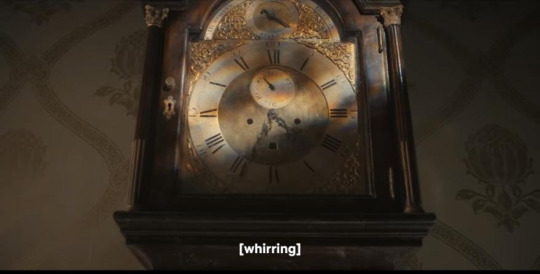
We don’t know if Nancy saw the clock spinning- so I’m not saying that Victor has powers and was spinning the clock, I’m saying that I wonder if the audience got to see the scene of Henry spinning the clock backwards, whereas Nancy was seeing something totally different (perhaps, Victor, wondering why the hell is his clock’s been turned backwards). Victor, who may have been angered that the “demon,” in his house was continuing to mess with his family by messing with the clock.
Admittedly, this last bit is more speculation than anything, but at the very least, the “Henry and Victor swapping places in the Massacre at Hawkins Lab script,” part of it is interesting considering that Alice and Virginia swapped places in the Dear Billy script, AND that Alice and Virginia swapped roles/places in the Indianapolis Gazette article.
And even though we have that Henry 1979 voiceover, it’s worth keeping in mind that the voiceover actually reinforces the idea that Nancy may be seeing something different- because the voiceover is happening in 1979 and Nancy isn’t hearing it, only the audience is, so it’s being used to manipulate the audience (likely manipulate them into believing that Nancy’s seeing what we’re seeing, despite the fact that the use of Nancy POV shots vs Nancy face shots contradicts that idea, like I talked about in this post and this post).
And there’s also the fact that there’s certain scenes and flashbacks that play during the Massacre at Hawkins Lab sequence that aren’t seeing by Nancy. Scenes like this one (No Nancy visible And doesn’t seem to be through her eyes, And she was supposedly downstairs seeing Henry at the dinner table when this scene played):

And scenes like this one, that are possibly flashbacks from Henry’s own mind/what would’ve been flashing through his mind in 1979 (this scene just shows up on screen when 1979 lab Henry is ranting about “they presented themselves as good, normal, people”:

So, I wonder if some of the clock shots are the same, especially ones that are through Henry’s eyes- shots that Nancy didn’t see because they’re only being shown to the audience/possibly as part of Henry 1979 actual flashbacks that he would’ve been having in 1979 while monologuing.
And the Victor-Henry swap in the Massacre at Hawkins Lab script just generally haunts me because we also have a Alice-Virginia swap in the Indianapolis Gazette *and* in the Dear Billy script, and I’m wondering if Victor swapped with Henry, or if he swapped with Edward, and the script swap is a nod to Victor and Edward swapping places in their family dynamic like Alice and Virginia did in the Edward timeline.
122 notes
·
View notes
Text



"When I was looking for a captain, I wanted a guy with the Red Wings crest tattooed on his chest," said former Detroit coach Jacques Demers, who named Yzerman captain in 1986. "Steve Yzerman was that guy."



happy birthday to the longest serving captain of any team in north american sports history… the youngest red wings captain ever… he holds the wings record for most assists and he's in second place to gordie for most goals, most points, most gwgoals, and most powerplay goals… he's a michigan man he's a girl dad he's our general manager and he's going to win another stanley cup for detroit, i promise
#sorry for being parasocial about those 90s hockey players. it will happen again.#anyways yayyyy stevie y day. o captain our captain forever#19#drw
10 notes
·
View notes
Note
do you know what the writers had in mind as models or influences when coming up with the second impact? I'm wondering if there's a link to "At the Mountains of Madness", either as a direct acknowledged influence, or maybe at one step removed, an influence of an influence.
A good question! So my first-order response to the Lovecraft element is going to be "no", for two reasons, but with the caveat that I have never seen any document specifically stating it one way or the other. The first is that (to answer the other part of the question) the Second Impact is not something that there is a lot of "behind the scenes" documents on. As its backstory its not a topic that comes up in interviews a ton, its not mentioned beyond its establishing facts in the Evangelion Proposal or (from what I have seen) production notes, etc. It lacks that elevated importance for us to get real answers on why its designed the way it is. So I don't have any real sources on, for example, "Why Antartica".
The second is that Hideaki Anno did not read or overly like western sci/fi & fantasy authors. Given Eva's positioning in the sci-fi genre he was asked, very frequently, things like "oh how much did Arthur C Clarke influence you or what do you think of Cordwainer Smith" and his response is usually "I don't read any of that shit lol". His influences are other anime & things like tokusatsu. So if I made a bet on "why Antarctica" for example, I would point to the ice planets in classic space anime, or even Anno's work on Nadia which has episodes in Antarctica. Or just a convenient way to flood the earth and get the apocalypse vibe. Lovecraft is not an influence I have seen the core team cite.
But as for Lovecraft being "in the water", that is a very different story. Lovecraft was very popular in Japan - even in the pre-Cthulhu boom days. And just like in the US, Sandy Peterson’s Call of Cthulhu RPG launched a boom in Lovecratian interest in Japan upon its translation & release in 1986. Manga adaptations, direct inspirations, references in other works, and so on are present in Otaku-adjacent media in the 80's & 90's. Chiaki Konaka (writer for Serial Experiments Lain) was a big Lovecraft fan and definitely drew from that for the work he did on tokusatsu series Ultraman, which Hideaki Anno loves enough to direct a film entry for last year.
And At The Mountains of Madness as definitely available in Japan, having been translated more than once into Japanese by 1990. It even has a full manga adaptation in the 2010's, if that appeals! So while I doubt you will ever be able to prove anything, the idea of Antartica having a touch of the horror vibe via serving as a tomb for dead gods being a culturally current idea, influenced in part by Lovecraft's works, seems as valid a guess as any to me.
As always, there 100% could be an interview out there I haven't seen that directly addresses this, would love to hear other's thoughts!
29 notes
·
View notes
Text
Fairy Tale Musicals: Little Shop of Horrors (1981) dir. Frank Oz
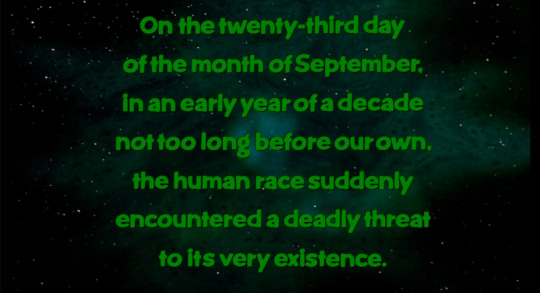
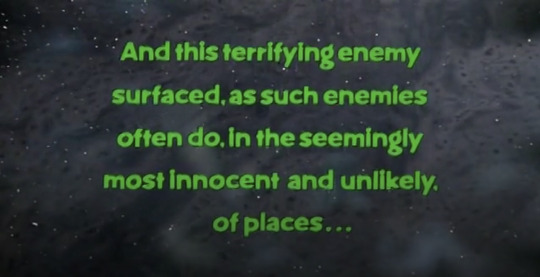
Little Shop of Horrors has a somewhat lengthy history of multiple adaptations. The first iteration of the story was the 1960 film The Little Shop of Horrors, with a screenplay inspired by science fiction stories of the 1950s. Then, the movie was adapted into an off-Broadway musical in 1982. In 1986, the popular musical was adapted into the high camp, soon to be cult-classic movie musical Little Shop of Horrors, directed by Frank Oz, whose experience in creating and puppeteering The Muppets would lend itself to Little Shop's impressive Audrey II puppets.



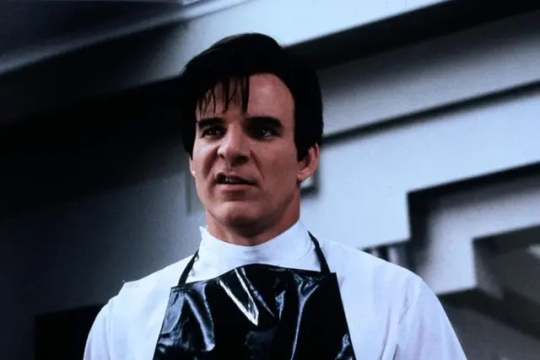


Three teen girls who live on Skid Row, Crystal, Ronette, and Chiffon, introduce and narrate the events of the film.
Seymour and Audrey are both struggling to make ends meet, and work at Mr. Mushnik's failing flower shop on Skid Row. Seymour, who has a hobby of collecting exotic plants, brings a mysterious plant to the shop, Audrey II, which draws in customers and gives the shop a fighting chance at staying in business. As the plant begins to make Seymour more popular and successful, he discovers that the only thing that he can feed the plant to make it grow is human blood. (Also it can talk and sing.) Meanwhile, Audrey's abusively masochistic dentist boyfriend Orin becomes more and more insidious towards her, making him into the perfect candidate for Audrey II's first victim...
Aesthetic Markers of Class, Race, and "Bootstraps" Myths Through Song
Though Oz's film is still set in the 1960s when its source film was made and generally parodies conventions of '60s B-movies, it is clearly influenced by the politics of the 1980s, when it was made. I will read Oz's Little Shop alongside two specific events: The Reagan Administration and the Second-wave Feminist movement.
Let's close read the musical number "Skid Row" to see how formal and stylistic elements enhance racial difference and enforce the "Pull yourself up by the bootstraps" rhetoric that became popular during the Reagan era as a way to justify and distract from the growing economic disparities in America.
youtube
Though the three narrators provide a segue into the song by exclaiming that there is no chance of "bettering ourselves" on Skid Row, Audrey and Seymour end the song determined to get out of their situations. They are notably the only two people in this ensemble number to sing about getting out of Skid Row, looking up towards the sky as the song ends while the rest of the cast looks down. Several other stylistic markers set Audrey and Seymour apart throughout the song, such as the bright lighting on only them, their brighter clothes/hair in comparison to everyone else's dull attire, and even the slower tempo and more gentle style of singing during their verses.
While Seymour and Audrey's economic status makes them "Othered" protagonists (much like Eliza Dolittle in Ray's analysis of My Fair Lady), the formal elements of this number serve to further Otherize people of color. It is important to consider Seymour and Audrey's whiteness in comparison to the ensemble, which consists of many Black performers. With these two white characters as the only ones to sing about wanting to get out of Skid Row while the others do not, the film contributes racist capitalist narratives that one's economic status is a "choice." This is further supported by the fact that the rest of the ensemble of this number rarely shows up throughout the rest of the film. Their only purpose is to foil the protagonists' strife, making the audience feel as though they are rooting for the "little guy" or the "Other" at the expense of another, racialized Other.
However, the narrative that continues after this song seems to subvert and rework this very same myth of finding economic success through the exploitation of The Other.
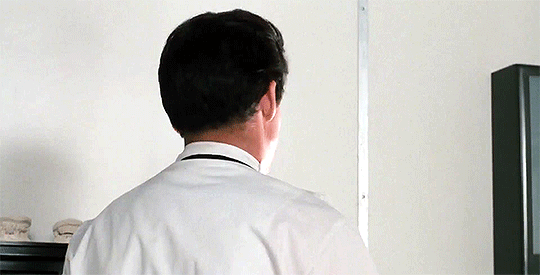
After finding out that Audrey II feeds on human flesh and blood, the meek and good-natured Seymour struggles to see anyone as "deserving" of death. That is, until Audrey II directs him towards Audrey's abusive boyfriend Orin. Fast forward a bit, and Seymour later feeds his boss, Mr. Mushnik, to Audrey II. The death of both these characters promote Audrey II's growth, which increases the attention it gets from the media and therefore brings Seymour more wealth.
Since the film dips into conventions of Sci-Fi and monster movies, it is expected that those who are killed for financial gain are bodies which have been marked as disposable or lesser. However, the victims in this film, a horribly misogynistic man with a good career and a boss who disregards the well-being of his workers, could easily be construed as heroes in other films. In this film, Seymour and Audrey II flip the narrative of violent exploitation, fighting against oppressive figures in order to succeed in the very capitalist system which they help promote.
Complicating Femininity Through Race and Class
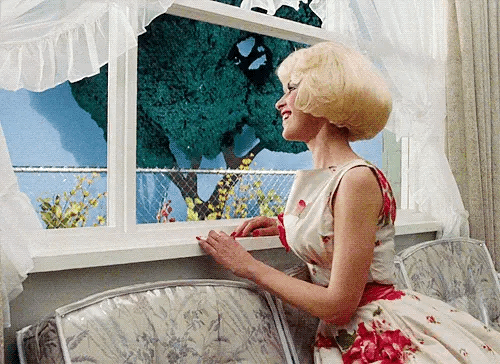
Ray writes of My Fair Lady as indicating what it means to properly "be" a woman through a rags to riches transformation. Little Shop sets up the perfect foundation for such a transformation to occur to Audrey, who defies any notions of demure, proper womanhood with her "trashy" style and nasally voice. This physical transformation never happens, though, and Audrey's femininity or womanhood are never in question.
Instead, Audrey undergoes an internal transformation through the film's exploration of domestic abuse, which seems to be informed by a heightened awareness of the issue thanks to the advancements of the Second Wave Feminist movement. I find that the film handles this issue surprisingly well, with Audrey experiencing symptoms of abuse in a way that is very realistic, and she is never treated as a source of blame for the abuse Orin subjects her to. When Orin's death frees her of her circumstances, she regains a sense of autonomy and self-confidence.
Audrey's "I want" song, "Somewhere That's Green," also handles contentious aspects of womanhood in a way which considers economic class. In this song, Audrey sings that her biggest dream in life is to live in a comfortable suburban home married to Seymour. While the Second Wave Feminist movement fought against the designation of women as housewives, such a lifestyle would be a privilege to Audrey in her current economic state.
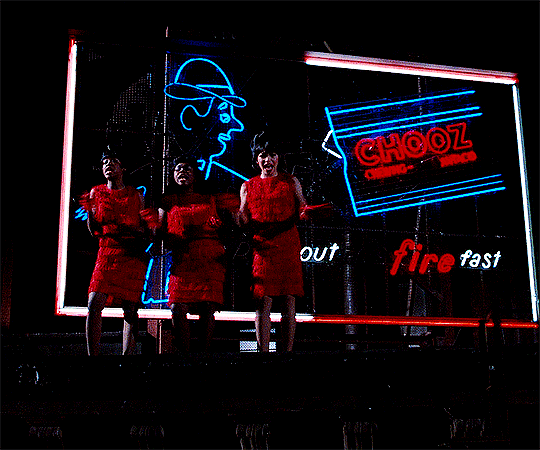
However, the film's three narrators are not given the same complex characterization. Ray writes of the "transgressive inner voice" of female musical protagonists as something progressive and empowering. The three narrators in Little Shop are basically only their voices (and they out-sing everyone else in the cast tbh), existing as an omnipotent presence that is only partially connected to the world of the film. Though the film definitely showcases their vocal talent and charm, they are reduced to an accessory with the sole purpose of narrating white stories.
Two Endings
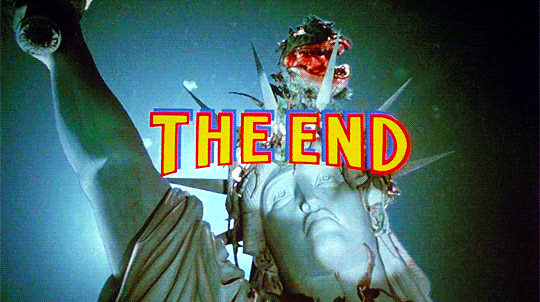
The film's original ending followed the ending of the stage musical. In this version, Audrey II kills both Audrey and Seymour. Businessmen take cuttings of Audrey II and sell it across the country, accidentally creating an army of Audrey IIs that take over the US.

After two test screenings which left audiences uncomfortable and speechless, Oz filmed a new ending before the wider release of the film. In this new conclusion, Audrey and Seymour survive, kill Audrey II and live happily ever after.
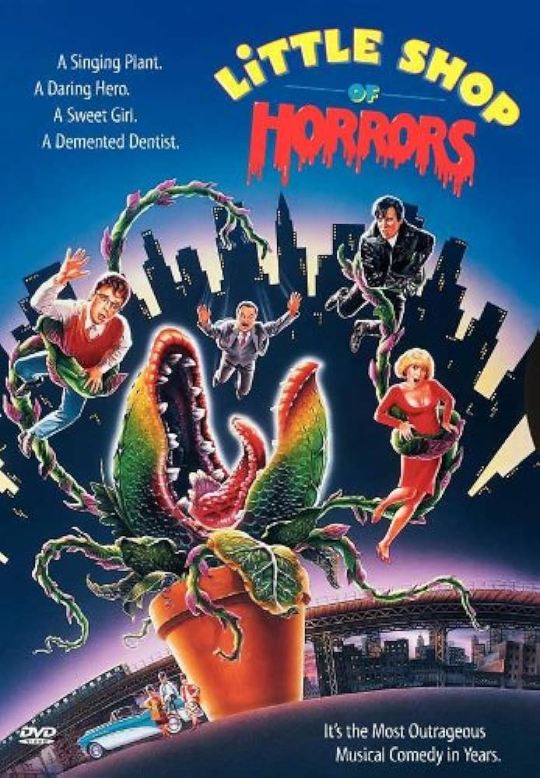
Discussion Questions!
Does camp and the tone of movie musicals make it easier to include anti-capitalist themes and narrative points? Might the film have been made and widely released if the same themes were conveyed in a more "serious" manner?
What is the significance of Audrey II being a plant, as opposed to another kind of being? Could there be an environmentalist reading of the film?
Why do you think the darker ending was successful in the stage musical, but made audiences of the film adaptation uncomfortable? Do stage plays and films evoke different expectations?
What do you make of the second ending and the role of happy endings more generally - can they evoke a sense of hope, or are they an unrealistic distraction from real issues?
19 notes
·
View notes
Text




Happy 69th birthday to Sir Timothy Laurence!
Born 1 March 1955, Vice Admiral Sir Timothy James Hamilton Laurence is a retired Royal Navy officer and husband of Anne, Princess Royal.
Laurence was commissioned a midshipman in the Royal Navy on 1 January 1973 and made an acting sub-lieutenant on 1 January 1975. He was promoted to lieutenant 10 months early, on 1 March 1977. Laurence then served briefly as the second Navigating Officer of the Royal Yacht HMY Britannia. Laurence was promoted to lieutenant commander on 1 March 1985. He attended the Royal Australian Navy Tactics Course at HMAS Watson, Sydney, in March 1986 during which he was notified of his first staff appointment as Equerry to the Queen, a post he held from 11 October 1986 until 16 September 1989. On 30 April 2007, he was promoted to vice admiral, and appointed chief executive of Defence Estates.
Laurence and Princess Anne married on 12 December 1992 in a Church of Scotland ceremony at Crathie Kirk, near Balmoral.
14 notes
·
View notes
Photo

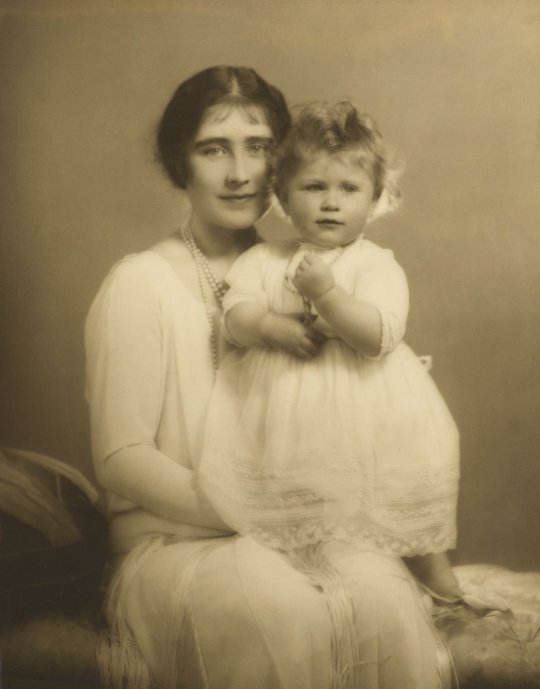


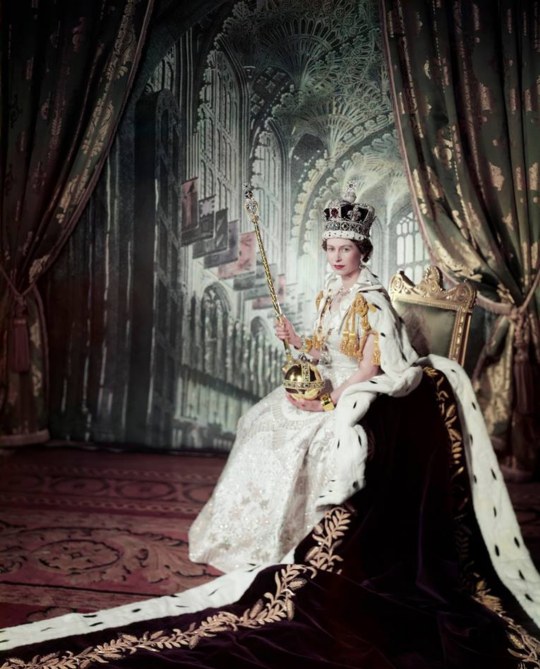
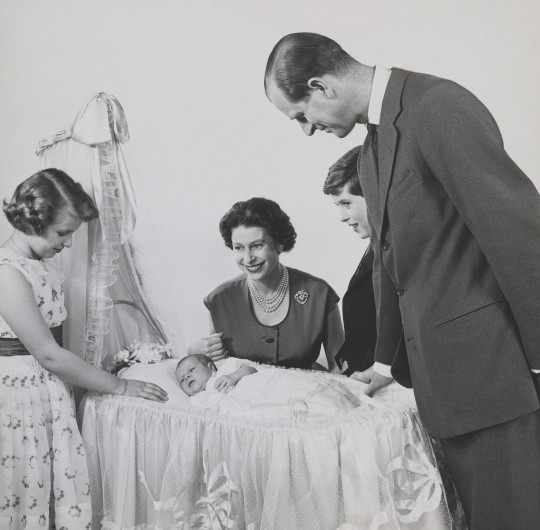


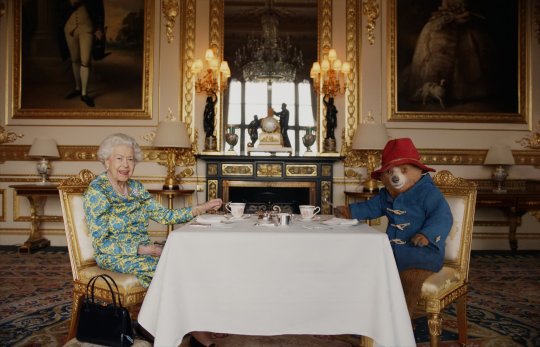

Queen Elizabeth II has died
Queen Elizabeth II, the United Kingdom’ s longest-serving monarch, has died at Balmoral aged 96, after reigning for 70 years.
Elizabeth II (Elizabeth Alexandra Mary; 21 April 1926 – 8 September 2022) was Queen of the United Kingdom and 14 other Commonwealth realms from 6 February 1952 until her death on 8 September 2022.
Her reign of 70 years and 214 days was the longest of any British monarch and the second longest recorded of any monarch of a sovereign country.
Elizabeth was born in Mayfair, London, as the first child of the Duke and Duchess of York (later King George VI and Queen Elizabeth). Her father acceded to the throne in 1936 upon the abdication of his brother, King Edward VIII, making Elizabeth the heir presumptive.
She was educated privately at home and began to undertake public duties during the Second World War, serving in the Auxiliary Territorial Service. In November 1947, she married Philip Mountbatten, a former prince of Greece and Denmark, and their marriage lasted 73 years until his death in April 2021. They had four children together: Charles III; Anne, Princess Royal; Prince Andrew, Duke of York; and Prince Edward, Earl of Wessex.
When her father died in February 1952, Elizabeth—then 25 years old—became queen regnant of seven independent Commonwealth countries: the United Kingdom, Canada, Australia, New Zealand, South Africa, Pakistan, and Ceylon (known today as Sri Lanka), as well as Head of the Commonwealth. Elizabeth reigned as a constitutional monarch through major political changes such as the Troubles in Northern Ireland, devolution in the United Kingdom, the decolonization of Africa, and the United Kingdom's accession to the European Communities and withdrawal from the European Union.
The number of her realms varied over time as territories have gained independence and some realms have become republics. Her many historic visits and meetings include state visits to China in 1986, Russia in 1994, the Republic of Ireland in 2011, and visits to or from five popes.
Significant events include Elizabeth's coronation in 1953 and the celebrations of her Silver, Golden, Diamond, and Platinum Jubilees in 1977, 2002, 2012, and 2022, respectively.
Elizabeth was the longest-lived and longest-reigning British monarch, the oldest and longest-serving incumbent head of state, and the second-longest verifiable reigning sovereign monarch in world history, only behind Louis XIV of France.
She faced occasional republican sentiment and media criticism of her family, particularly after the breakdowns of her children's marriages, her annus horribilis in 1992, and the death of her former daughter-in-law Diana, Princess of Wales, in 1997.
However, support for the monarchy in the United Kingdom remained consistently high, as did her personal popularity. Elizabeth died on 8 September 2022 at Balmoral Castle, Aberdeenshire.
“The Queen is dead, Long live King Charles III”
The Duchess of York with Princess Elizabeth, 30 June 1927 by Marcus Adams (The Royal Collection Trust),
Princess Elizabeth in uniform (1942) by Cecil Beaton (The Royal Collection Trust),
Princess Elizabeth and The Duke of Edinburgh on their wedding day, 20th November 1947 by Sterling Henry Nahum ‘Baron’ (The Royal Collection Trust),
Queen Elizabeth II poses on her Coronation Day on June 2, 1953, in London (Photography by Cecil Beaton),
Queen Elizabeth II with Prince Philip, Duke of Edinburgh and family - 16 Mar 1960 by Cecil Beaton (From the Collection of Queen Elizabeth The Queen Mother),
Queen Elizabeth II and her son, the Prince of Wales, out riding at Windsor Castle I May 18, 1961 (PA),
The Royal coat of arms of the United Kingdom used outside of Scotland,
Queen Elizabeth II Platinum Jubilee 2022 - Platinum Party At The Palace. The Queen Elizabeth II and Paddington Bear having cream tea at Buckingham Palace (BBC Platinum Party at the Palace),
Portrait of Queen Elizabeth II released by The Royal Windsor Horse Show on April 20, 2022 to mark the occasion of her 96th birthday.
#rip#queen elizabeth ii#elizabeth II#queen elizabeth#monarchy#united kingdom#royal#platinium junilee#windsor#markus adams#cecil beaton#theroyalcollectiontrust#paddington#bbc#balmoral#diana#king charles III#princess anne#prince andrew#prince edward#liveunique#history#britsh history#british royality
345 notes
·
View notes